Now Happy, Hopeful Brazilian | She/her | Used to write about midia,GUESS I DO ART NOW? Something like that
Don't wanna be here? Send us removal request.
Note
I hope your wrist feels better! 💕
Thank you so much!!! It's healing way better now!
Your message warmed my heart, thank you again ❤️
4 notes
·
View notes
Text
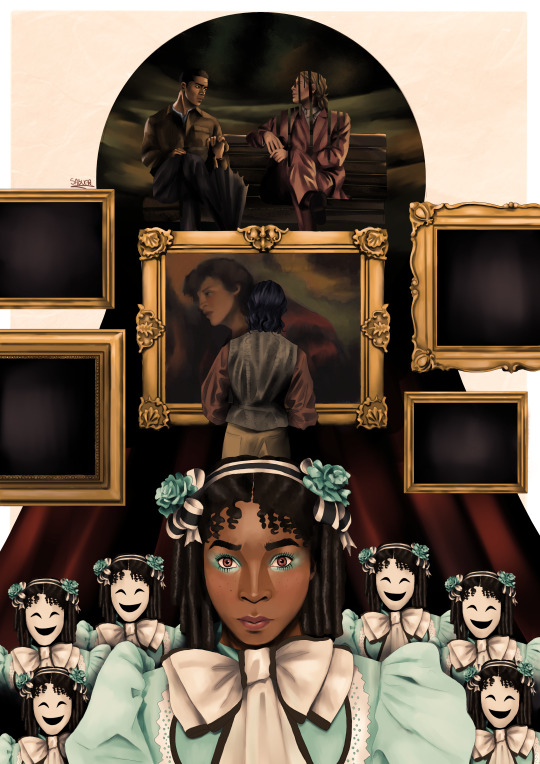
Ep.4: I Want You More Than Anything In The World
#interview with the vampire#iwtv s2#iwtv spoilers#I injured my wrist las week so I couldn't finish episode 3's drawing in time#but didn't want to fall even more behind#so here you have it#god help me through episode 5's#louis de pointe du lac#claudia de pointe du lac#lestat de lioncourt#armand
273 notes
·
View notes
Text
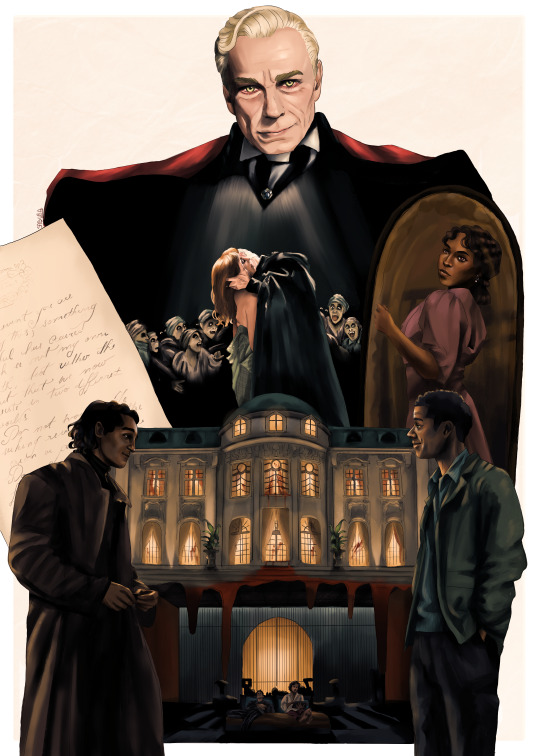
Ep.2 - Do You Know What It Means to Be Loved By Death?
#interview with the vampire#artists on tumblr#art#iwtv#iwtv s2#iwtv spoilers#louis de pointe du lac#armand#claudia de pointe du lac#God is seeing my laziness in the bedroom part but oh well#I'm never doing buildings ever again#or mirrors
2K notes
·
View notes
Note
Oi. Eu sou de Porto Alegre. De onde vc é?
Oii! Eu sou do interior de São Paulo
0 notes
Text
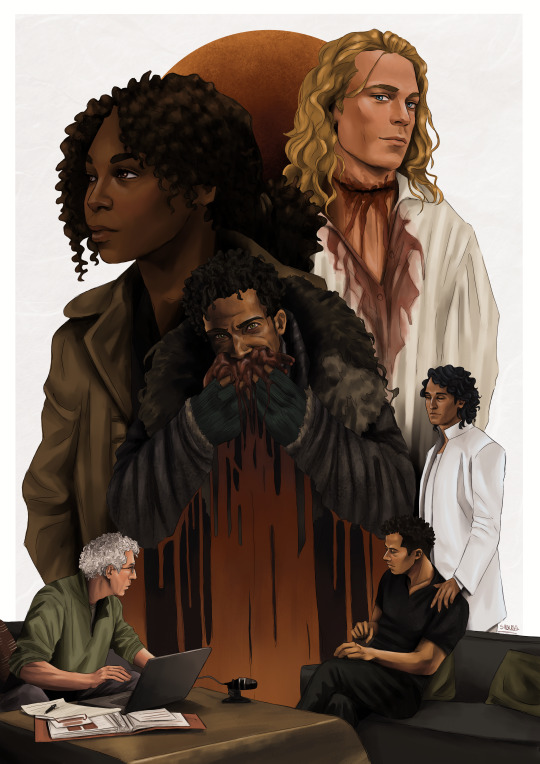
Ep.1 - What Can the Damned Really Say to the Damned
#interview with the vampire#iwtv#iwtv s2#painting#not me really thinking I can make a drawing per episode#but it's nice to dream#lestat de lioncourt#louis de pointe du lac#daniel molloy#armand#claudia#illustration#artists on tumblr#art
2K notes
·
View notes
Text
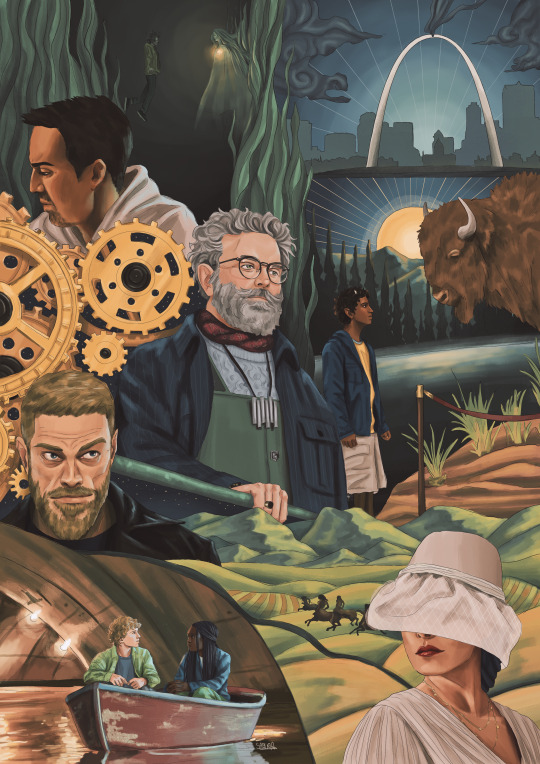
A quest is a sacred thing. And to be charged with one is to be in conversation with the gods themselves.
#percy jackson#percy jackon and the olympians#pjo#tumblr art#pjo series#art#percy jackson show#my art#grover underwood#annabeth chase#now I really might have gotten carried away fr#I'm now looking back at my previous one and resisting the urge to redraw it#already planning the final episode's one#you guys have spoiled too much with your love and support#percy jackson tv show#percy and annabeth
456 notes
·
View notes
Text
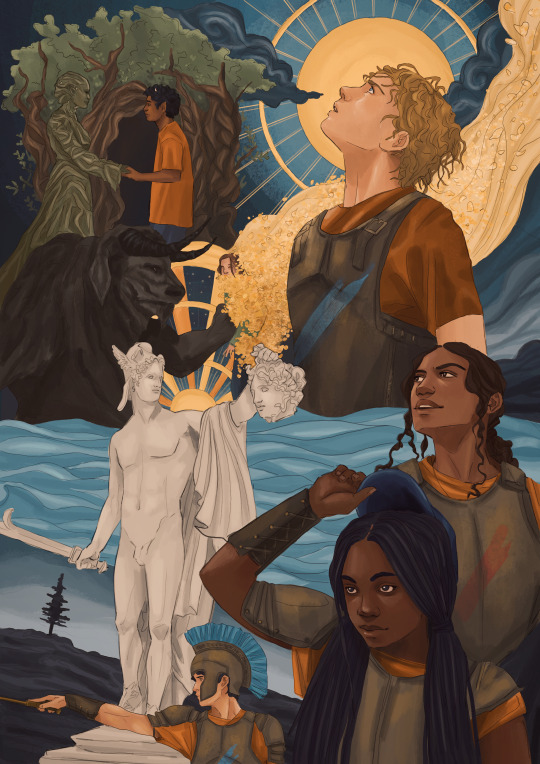
Hold fast. Brave the storm
#percy jackson#percy jackon and the olympians#pjo series#pjo#illustration#artists on tumblr#might have gotten a lil carried away here#not gonna lie#this series is just so pretty#rick riordan#can't draw a minotaur to save my life tho#annabeth chase#clarisse la rue#luke castellan#grover underwood
32K notes
·
View notes
Text

Days before disaster
#percy jackson#percy jackon and the olympians#pjo#tumblr art#pjo series#rick riordan#luke castellan#already getting my outfit ready to justify any warcrime commited by this lil lad#his father is lin manuel miranda your honor#he is not accountable for his actions#i'd probably do worse in his conditions#he looks way nicer in the trailer tho but i'm sticking to my book-lens here for now#pjo tv show
1K notes
·
View notes
Text
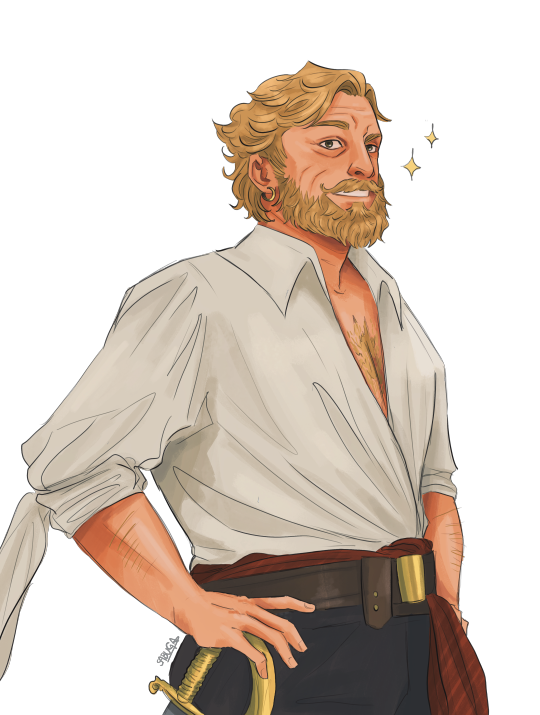
Serving 💅
356 notes
·
View notes
Text
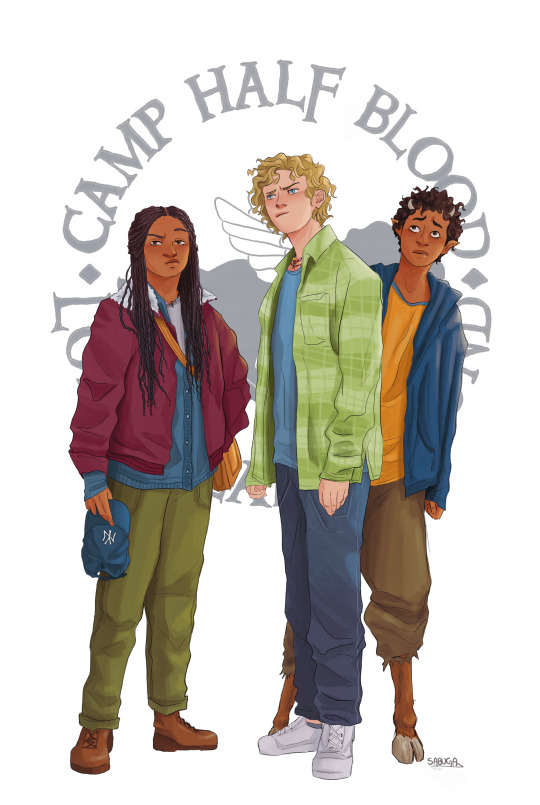
They are gonna be so personal to me
#percy jackson#percy jackon and the olympians#artists on tumblr#tumblr art#pjo#finally got the courage to post art in here the pjo effect is already starting
1K notes
·
View notes
Note
I know you don't usually do these kinds of posts, but you're probably one of the most implicated in black history month people that I follow so I wanted to ask you, as I already value your opinions in Acotar, what do you think of the documentary where actual historians claim Cleopatra was a black woman? Lately, this has been a pretty active topic on my fyp on TikTok, and I wanted to know a black woman's perspective on this.
Thank you in advance, and if you usually don't answer these questions or don't want to answer this one, I'll totally understand, and there's no problem at all.
I didn’t know there was a new documentary out, but when I saw the name Cleopatra I automatically sighed because I knew what was coming. This is a subject a know a little 🤏🏾 about, actually, because I researched it a bit myself in my last year of high school (and stopped because of the uh. NASTINESS associated with this particular subject) and though it’s been a few years I remembered some main, basic things, and I wanted to check a few things first.
At best, in the most CHARITABLE interpretation as far as I in my limited knowledge can tell, it would be correct to say that’s it’s POSSIBLE that she MAY have been mixed Black because, though she was part of the GREEK Ptolemaic dynasty that ruled Egypt (Ptolemy being one of Alexander the Great’s generals who got the Egyptian portion of his empire after Alexander died), that’s on her fathers side; her mother’s exact ethnicity isn’t known. Not that this won’t stop the hoteps from running off and claiming her and all of ancient Egypt as Black though So some have ***speculated*** that her mother—and thus Cleopatra—may have potentially been part Egyptian (and that goes into the issue of deciding that the “Egyptian” in this instance had to have been Black rather than MENA but that’s again a whole other can of worms). BUT it’s more likely that her mother was Greek due to the uh, PRACTICE™️ of inbreeding and it not being common for the dynasty to marry Egyptians. So it’s more probable that she was fully Greek/Macedonian and not part Egyptian, much less part Black. (Also some historians speculate she may have had Persian blood? I guess? Again it’s a can of worms, not something i’m digging deep into because of the nastiness that you often stumble across) Unless there’s a new study confirming her mother’s identity or something that I missed, it’s simply incorrect to claim that Cleopatra was undeniably Black, because though it is ***possible*** she most likely ***wasn’t.***
But this topic really upsets me, because there are LEGITIMATE Black kingdoms and empires who were mighty and well developed and powerful like the Aksumite empire and kingdoms of Kongo and Loango and the Great Zimbabwe empire and the empires of Ghana and Mali and Songhay and the Ashanti kingdom and the WHOLE SWAHILI COAST THAT WAS INVOLVED IN THE INDIAN OCEAN TRADE ROUTE and they had their own great rulers, their own kings and queens and emperors and empresses, their palaces and castles, their own cities and towns, their own complex civilizations and dynastic royal families that deserve the attention Cleopatra and ancient Egypt get. They were erased—and Egypt was not—by white people to prop themselves up as the only race capable of forming civilizations and advanced societies as a means of justifying colonization and imperialism to “civilize” the rest of the world and as a result many of those other empires have been erased from our education system here in the states and many people cling to ancient Egypt as proof that we’re not inferior and aren’t savages like white people claim due to believing that since Egypt’s in Africa it had to have been mostly Black when Egypt, and the Ptolemaic dynasty and Cleopatra in PARTICULAR, are literally the worst example that could’ve been chosen and were the only African kingdom spared erasure FOR A REASON.
Anyway, I don’t like it, it’s disingenuous and does US wrong because we need to give that energy to other African kingdoms that need and could use the fame Egypt + Cleopatra get, and we deserve a better education system to teach us this stuff. I hope this answers your question? And I don’t mind any kinds of asks 🥰
1K notes
·
View notes
Text
RRR, Black Adam and the Response of the Oppressed
OR: The Colonial Wound and how to approach Violence as a solution against the mechanisms of oppression
OR: how to get the debate right VS how to ruin it completely

Spoiler: RRR gets it right
So, I was keeping this one to myself because it's a very delicate subject, but rejoicing in RRR's recent Golden Globe nomination, I thought hell might as well talk about it.
First of all, a very important disclaimer:
I am not here, in any way, defending or endorsing any side in this debate. My personal views on violence and armed struggle and guerrilla warfare are not what I will be addressing. Armed struggle, is an extremely complex issue that is still being debated today by theorists and academics much more qualified than I am, so no.
Rather, my aim here is simply to address how this debate has been represented, and my take on this issue: media portrayals of social, historical and most importantly, decolonial debates. And recently in 2022, we've had two approaches (And yes, I am fully aware that this topic is much better covered in dozens of media that have this debate entirely as their main focus, but I am talking about superhero blockbusters here, so keep that in mind) that may seem similar, but are fundamentally completely divergent:
The Telugu movie RRR (Rise, Roar, Revolt)
And curiously, DC Film's Black Adam
No need to say, there'll be major spoilers ahead, so be warned
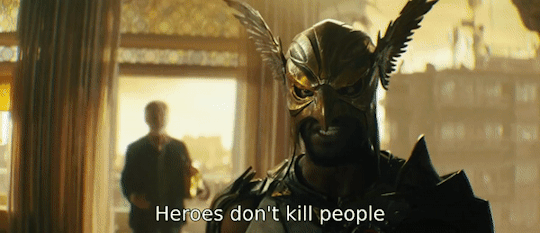
1. THE RESPONSE OF THE OPRESSED
Before I start, I would like to clarify as briefly as I can some terms and concepts that I consider necessary to begin to understand decolonialism and the response of the oppressed, a term that was coined in the famous quote by Jaylen Brown during the height of the BLM movement, "Do not confuse the response of the oppressed with the violence of the oppressor".
Pierre Bourdieu differentiates the violence of the oppressor into two categories:
explicit violence – in which the action of the dominant subject is visible (and therefore, in our current society, subject to questioning and legal or moral limitations)
and symbolic violence – conceptualized by Bourdieu when he addressed the issue of male domination in society and all the faces in which it presents itself – and we see it everywhere, from racial demographics in income distribution to that homophobic joke your uncle always makes.
This relationship of systematic domination can be understood as a chain, and in view of the necessary rise of awareness and consequent rupture of this chain, Audre Lorde presents the uses of anger.
By connecting the idea of symbolic power and the breaking of the domination relationship with the use of anger, we have the explosion of a natural reaction of the oppressed triggered by centuries of imprisonment in their own fear and, bringing this reality specifically to colonial relations, using anger over your own fear results in liberation. (source)
And although it wouldn't hurt to address the revolutionary terms in its most famous roots in the French Revolution and etc, here it seems more fitting to comment on Marx. And class struggle.
Briefly, Marx and Engels saw revolution as the result of organized political action by the exploited. Therefore, one can only speak of revolution when there is a rupture with the old political, social and economic order; and in its place, new standards of social relations are established whose principle is to ensure freedom and social equality among men.
This is what we mean when we talk about inverting the social order, and Marx will also use the terms infrastructure (productive forces + relations of production) and superstructure (politics, police, army, law, morals, religion, etc.).
The superstructure, for Marx, is created by the most favored and dominant class, but determined or conditioned by the infrastructure.
Therefore, the revolution would happen when the working class (and in that logic, any oppressed group) reversed the order and took control of the superstructure.
In short, this can be understood as the basis of revolutionary thinking.
Now apply this to the invasion, colonization and genocide scenario, and you'll see where I'm going here.
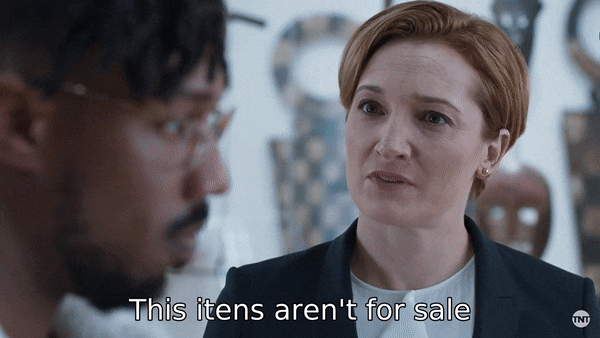
KKKKKKKKKKKKKK THAT'S A BIT EXTREME EXAMPLE SORRY but actually in Black Panther I the plot could very well be read through Marxist lens (and that has certainly been done), but I won't even go into that here, god forbid Wakanda Forever hahahah imagine that, anyway going back to my thread
2. ARMED STRUGGLE
A quick definition of armed struggle, which can be found in dictionaries, is armed resistance against oppressive regimes. In the armed struggle, the militants understand that the situation of society requires drastic action so that it can be modified, and for this reason they decide to take up arms and declare war on the oppressive regime. Guerrilla warfare is an example of armed struggle.
In the armed struggle, a group of militants opposed to the current regime in a given society, organize actions that can be strikes, attacks on barracks or public buildings, etc, aiming to destabilize the current power with the aim of overthrowing it and placing a different regime in its place, like a democracy, for example – in general, the armed struggle follows a leftist tendency. (source)
In Brazil, for example, the armed struggle appeared mainly as resistance to the Military Dictatorship between 1964 and 1985.
All of this goes along the idea of using violence as resistance to oppression (as already pointed out before): fire is answered with fire. In the specific scenario of the guerrilla, the French philosopher, journalist, former government official and academic Jules Régis Debray writes the controversial book Révolution Dans La Révolution, where he points out that "The main objective of a revolutionary guerrilla is the destruction of the enemy's military potential"; the enemy is stripped of it's military power (it's weapons) to ensure a greater chance of victory.
"To destroy an army you need another army.", Debray says. "Precisely because it is a mass struggle, and the most radical of all, the guerrillas need, in order to triumph militarily, to gather politically around themselves the active and organized majority, since it is the general strike and the generalized urban insurrection which will give the coup de grace to the regime and destroy its latest maneuvers - last minute coup d'état, provisional junta, elections - by extending the struggle throughout the country." (source)
Does that all ring a bell?

Sure it does.
Now, these are all historical scenarios, and nowadays the moral debates about armed struggle have become extremely more complex (as they should), and the disarmament discourse is taking more and more space in these debates. Is armed struggle the only solution? Wouldn't there be others?
But it is still a complex debate. The Brazilian rapper (and political thinker and, dare I say, philosopher) Mano Brown, a strong advocate of disarmament, staunchly defends that violence, most of the time, bounces back on the oppressed, not the oppressor.

Look at him all precious
He argues, however, that one cannot simply condemn the oppressed who react violently. Already in 2006 he presented in an interview that:
"I am in favor of disarmament, but this argument is difficult, things should be done differently […] People are coming as a class struggle, you know? Rich people don't want poor people to arm themselves and remain unarmed. And poor people don't want rich people to arm themselves and remain unarmed. Did you see the kid's argument: "How are the police allowed to carry guns while I remain unarmed? " It's kind of uneven. It's confusing." (source - translated by me)
Mano Brown is part of the Brazilian rap band Racionais formed by 4 black men from the periphery, who revamped their music after realizing that it could be used to foment violence. They front a series of social programs, and revolutionized the way peripheral music is seen and consumed. Nowadays, in 2023, Mano Brown hosts one of the biggest political interview podcasts in Brazil (having even interviewed Angela Davis), is considered one of the most active leaders of the racial struggle, and along with the other members of Racionais, has taught open classes in estate universities.
The Brazilian educator and philosopher Paulo Freire, considered one of the most notable thinkers in the history of world pedagogy, inaugurates in his book Pedagogy of the Oppressed (you can read it translated right here) the idea of the liberation pedagogy. He strongly emphasizes that liberation pedagogy is a political process that aims to awaken individuals from their oppression and generate actions for social transformation – through education.
NOW WITH ALL THAT IN MIND WE CAN FINALLY MOVE ON TO WHAT MATTERS,
3. THE MOVIES
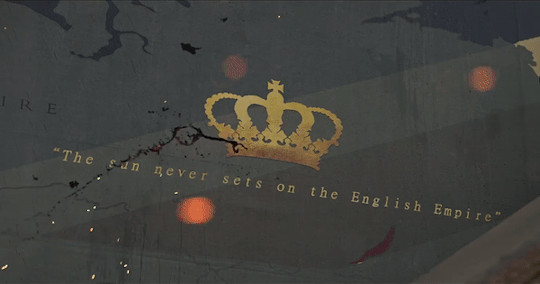
I'm going to talk about RRR here first because it makes me happier, but for reasons of time and your patience I'm not going to extend myself so much in the analysis of this film technically, and if you want a more detailed look at the grandeur and the importance and the genius of this film, please watch any of the many videos that are now appearing on youtube on the subject (I recommend RRR: Make Movies EPIC Again, by Jared Bauer, and The Importance of RRR, by the wonderful Accented Cinema)
ONCE AGAIN ATTENTION FOR BIG, MAJOR SPOILERS AHEAD
The story therefore revolves around two men: Raju, who infiltrates the British army to steal fireguns and deliver them to the people's guerrilla, and Bheem, a Gond leader who is after Mali, a child of his people who was kidnapped by the British to basically serve as a pet.
They meet under false identities, and unaware that they were both fighting for the liberation of India (through different methods), the two men form an extremely strong bond of love and friendship, which results in their struggles coalescing into an evocation of patriotic unity and popular resurgence against the colonial forces.
First of all, RRR is a fictionalized biography of two real-life Indian revolutionaries, Alluri Sitarama Raju and Komaram Bheem. So, in real life, Alluri Raju actually stole guns from the British to stage uprisings against the British Raj, and Komaram Bheem really was a Gond revolutionary leader who coined the slogan Jal, Jangal, Zameen (transl. Water, Forest, Land) wich became a call to action for Adivasis (or Scheduled Tribes) peoples.

You can see the flag in the last scenes
This "historical aspect" (in addition to the incredible, completely impossible and impossibly glorious action scenes) makes it plausible to draw parallels between RRR and Tarantino's historical revisionism films like Django Unchained (2013) and Inglourious Basterds (2009), where in all cases we see scenes of extreme violence that somehow feel justified, or cathartic, for being directed against oppressors (slave masters, Nazis, British colonizers, etc etc)

The parallels are just there.
Black Adam, on the other hand, states in its synopsis that "After nearly five thousand years of imprisonment, Black Adam, an anti-hero from the ancient city of Kahndaq, is released in modern times. His brutal tactics and righteous ways attract the attention of the Justice Society of America, who try to stop his rampage by teaching him to be more of a hero than a villain, and they all must band together to stop a force more powerful than Adam himself."
So we have a superhero story set in the present day in a fictional country on the Sinai Peninsula (that means, right there besides the Gaza Strip and the Suez Canal), occupied by a mercenary crime syndicate called Intergang, who brutally oppresses the Kahndaqi people while robbing their mineral resources. All good, all great.
But as stated in the synopsis, the film's great moral conflict revolves around whether the use of violence against mechanisms of oppression is justified or not.
Basically,

And while these two scenarios may seem similar, the approach the two films take to this debate, which, as I've said before, is EXTREMELY DELICATED, and EXTREMELY COMPLEX, is completely different. Firstly, because RRR is the only one of the two that treats it as, well, a debate.
From the beginning, RRR establishes the two characters as essentially polar opposites; Raju is fire

Look at the scenery with the european buildings in the background
Bheem is water
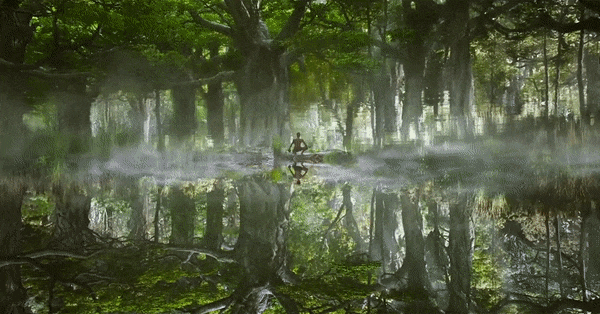
And here, the native, untouched forest with pure cristaline water
Bheem is the god Bhima, immovable, patient and resilient
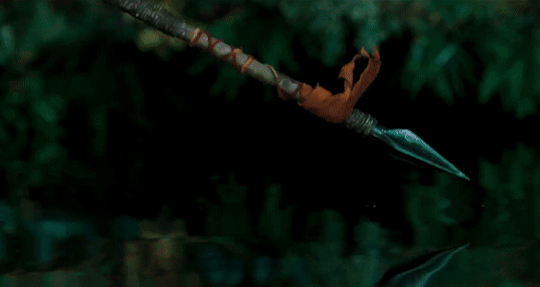
(like water)
And Raju is the god Rama, heroic, springy and skillful
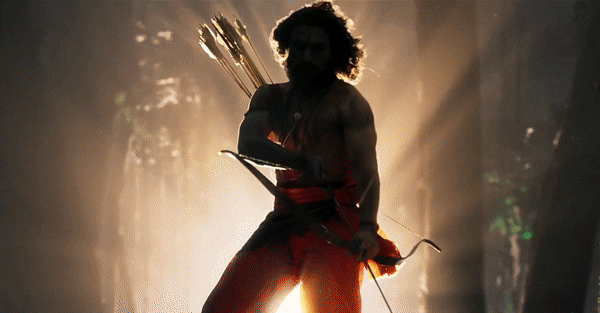
(and hot)
Bheem is the legs (the foundation) while Raju is the arms (the action)
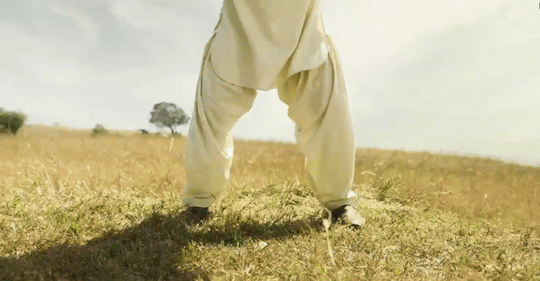
They ✨ complement ✨ each other
And this is translated into their different approaches to the revolution: Raju with his arms policy (inherited from his guerrilla father), who operates within the system to overthrow it, and Bheem with his native philosophy, using the land, the fauna, the culture, the religion, the people themselves as agents against oppression, operating from outside the system to overthrow it.
At the beginning of the film, Raju dresses Bheem in western clothing so that he can attend a British party (which allows him to know the building and locate Mali), and at the end of the film, Bheem dresses Raju in the traditional clothing of the god Rama, and arms him not with european firearms but with a sacred bow and arrow, evoking his native homeland in what configures the real defeat of the colonizers.
Not even getting into the merits of comparing these two films technically, just talking about the discourse itself, what for me fundamentally separates RRR from Black Adam, and even Django and Inglourious Basterds, is precisely Bheem's character. It's the other way to fight (but fight nonetheless)
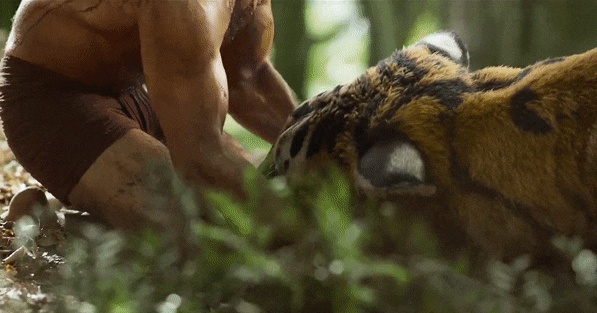
This does not mean that the armed struggle is delegitimized, or diminished. On the contrary, it is explained, justified (within that historical and social context) and respected. People who fought in the armed struggle, and died in the armed struggle, are honored and respected. It allows you to understand where the idea of arming the population is coming from (in a certain parallel with Mano Brown's interview that I mentioned above), but it also presents other discussions on the subject, that happened at the time, and still happens today.
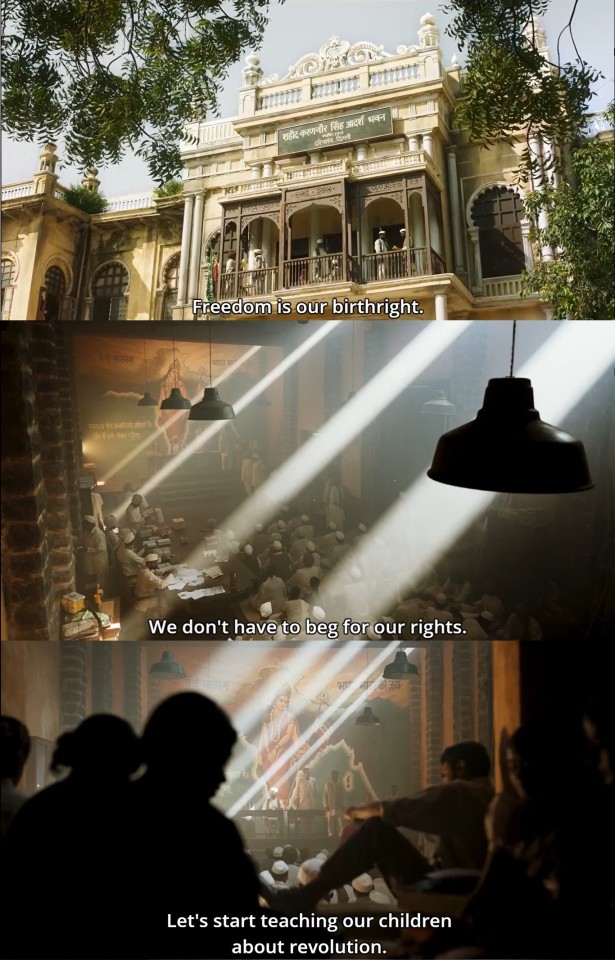
And above all, as I mentioned before, the film presents and reinforces the idea of inspiration. Even if education is presented only very briefly, in a popular assembly, in the long term, the film still gives extreme focus to the importance of raising awareness among the oppressed people.
This can be clearly seen in the scene where Bheem is being tortured in a public square by the British government, and refuses to kneel.

So when the torture becomes too much to bear, he starts to sing

Now, this is the most important scene in this movie and I'll die on this hill
And then, this happens
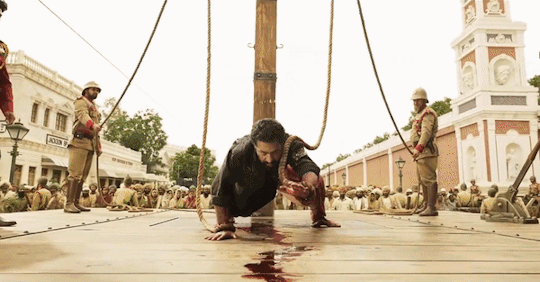

Bheem inspires not only the population, but also Raju, who even after years of enticement by his own father, steps back on his original (armamentist) plan when he realizes that "I was under the impression that guns would bring us freedom. But Bheem inspired a whole crowd with one song"
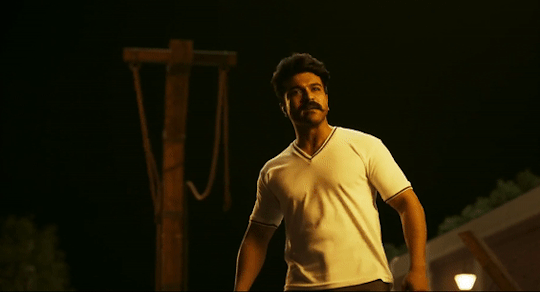
Even though in the context of the film the "path of choice" was still violent (this still is, after all, an action superhero movie), the message of this scene is extremely metaphorical. The idea of a song (art) inspiring all people to "become a weapon" against an oppressive regime is very powerful, and it resonates deeply in anti-opression movements all over History. It is, literally, the power of the people.
Furthermore, at crucial moments in the plot, both Bheem and Raju put aside their collective struggles for the other's individual good; Unlike his father, who readily accepts the militarization of his child son for the greater good, Raju, when questioned by his guerrilla companion for abandoning 15 years of work to save Bheem, says that "I will bear it for another 25 years, but I won't sacrifice Bheem for my goal".
Bheem, here, represents not only the friendship and love between them, but, metaphorically, an entire ideal of the people. Ultimately, one can say that this film addresses the idea of "what are the limits in my revolution": I will not sacrifice the other for my revolution; the limits of my revolution must be the wellness of the other (and in our metaphorical reading here, the wellness of the people).
Parallel, the torture scene can be metaphorically read as: the only valid sacrifice is my own, never that of the other. (and I won't be commenting on the revolutionary character of ideas like martyrdom and self-sacrifice, but yes). That's what Bheem and Raju do throughout the entire film, they put the other above themselves.
And in the end, they kill the british defeat oppression together✨
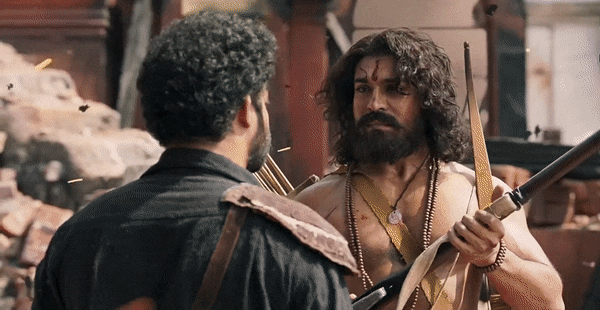
Now, as I've mentioned before, yes, this movie still ends violently, yes, it still glorifies and celebrates this violence in some of the best action scenes I've seen in my whole life, yes, it is heavily patriotic and sometimes a little bit too on the nose about it, yes, and did I rejoyce in it? Yes.
But it cannot be denied that RRR at least presents a reflection not often seen in films of the genre, which is the mere existence of real debate. In addition, the film is placed in an extremely specific historical context, portraying real historical figures, real life revolutionaries, folkloric parallels, a gigantic symbolic charge, in short, a whole other deal.
Besides it, the only difference between this film and idk, Braveheart, or Star Wars, is that in this film the social and racial parallels, the guerrilla warfare and class struggle (and the colonial wound) become clearer – and perhaps this is a more responsible way of representing a revolution.
NOW, BLACK ADAM ON THE OTHER HAND KKKKKKK
As mentioned in the synopsis, the background of Black Adam is curiously similar: we have an oppressed people, we have the militia, a clear racial reference to a real-life conflict, which affects thousands of people daily, and the figure of a mythologically evocative hero with super powers who will free the people from oppression through violent means. And yes, there is debate: we have the Justice Society, which condemns Black Adam's methods and questions his use of violence, only to be proven wrong at the end of the movie.
But the "proved wrong" isn't really built, or developed (as Intergang is quickly forgotten when they all start fighting each other and then… Satan? For some reason??), and it basically boils down to this:
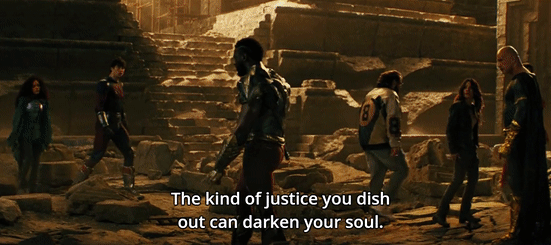
KKKKKKKKKKKKKKKKKK
And that's so funny because he actually just… killed like 3 soldiers in the second act of the movie. That's all he did.
And it gets even funnier because at some point we have a scene that genuinely makes a VERY VALID point that made me very hopeful when I was in the theater watching it

Like, this is SO VALID and she is SO RIGHT and this is such a great argument and a great debate point and then it just... goes nowhere

He just killed like 3 guys he didn't even talk to the people he just, quite literally, killed some pawn soldiers and went on to fight his own individual battles that had nothing to do with the actual opression state of the country besides them telling you that "it was bad".
The problem with Black Adam's is ac how shallow the argument is. Nothing is justified, nothing is not even debated, we just have Hawk Man going "killing is bad" and Black Adam going "yeah but I do it caused I'm disruptive like that", and even when we have this "inspire the people" moment is just... this kid with a cape doing this symbol and yes, symbols of struggle are a great tool in fighting oppression, and yes they work and they're so, so great, but this one specifically kind of just…was there?
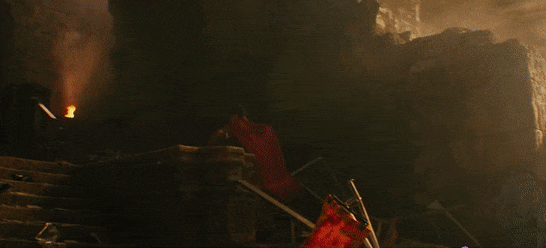
LIKE OK THIS IS ALL GREAT but then it lead to people… fighting zombies?????
zombies ??!?!??!!!????
Like, how, seriously, how does this have to do with any of your previous state of opression? How does this change absolutely anything??? Are we going to have elections after the zombies thing, or... ?
And that, to me, is such a poor and wasteful way of representing people power that, even though I didn't take this film seriously, I couldn't help but feel mildly frustrated. Much of the recent wave of blockbuster media about decolonialism, in my opinion, has been making this same mistake, which is apparently thinking that just because a movie is made to be a blockbuster, or a superhero movie, or an action movie and easy entertainment, it cannot tackle complex topics. It cannot deepen a discussion. It can't take 10 minutes off a fight scene to establish a full dialogue. As if that would, idk, tire the audience maybe? Idk.
As if a universe of superheroes, or fantasy and action, couldn't contain a scene like this:

This scene seems so simple but it is so, so huge
Andor is perhaps an example out of the curve, because Andor is a series that makes a great effort to represent the fight against oppression in a very serious and responsible way, making it its main theme, of representing what a fascist government is,how a fascist government acts and affects all layers of a population, what is the immigrant cause, what is the armed struggle, what is it like to be a person of color in an far-right government. And it does all of this in an unprecedented way in the genre so far, indeed.
But as I said before, perhaps this should be how all media represent these themes. Because otherwise, even the best of intentions can turn against the causes you sought to defend. And ok, I know that Black Adam is "just a superhero movie" and that maybe it's unfair to demand so much from a movie that only came to propose a simple entertainment with fight scenes and jokes, and I had fun watching it indeed. I love Dwayne Jhonson we all do. But the thing is, if you're going to represent that debate, I genuinely believe it can't be done as simply, or as poorly explained, as it was in this film. A poorly presented arms discourse can become an attack on the legitimization of the armed struggle in its historical context, it can become a justification for a shootout against anti-oppression demonstrations, it can become the excuse for why a policeman mistook an umbrella for a rifle, or a piece of wood for a gun, and killed innocent (and peripheral) men.
In the best of scenarios, the intent is simply forgotten, or it's so hidden in the metaphorical layers of the work that it's easy to miss them. If that weren't the case, there wouldn't be so many racist, misogynistic, right-wing Star Wars fans, for example (just to be clear, I'm not attacking Star Wars here at all, ok, I'm just using it as an example – you'll agree with me that I've never seen any Cambridge professors attack Star Wars)
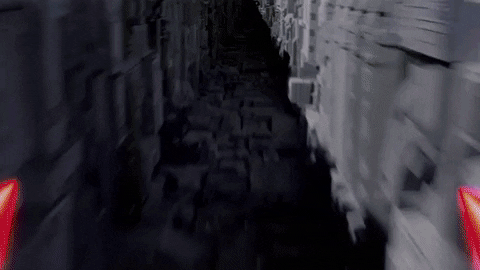
And fair is fair, Luke did explode a moon-sized military base full of millions of people and all that...
SO ANYWAY
Armamentism is an extremely serious issue, and it must be handled very, very carefully. As I mentioned before, RRR has a historical context, and an argument builded throughout the entire film; I hardly think anyone comes out of RRR, or WomanKing, wanting to pick up a gun and simply shoot someone (I hope). But the way this idea was presented in Black Adam, it is not an exaggeration to say that someone might have had this impression after watching it. At the very least, the movie took no care making sure this wasn't the case, and that for me is troubling enough.
The struggle against oppression and decolonialism are extremely important topics, and I am happy that these themes are increasingly making themselves present in more and more media works (and we have had several very good ones recently) – and Black Adam does have good ideas in the middle of the mess. But if you're going to make a film to talk about oppression, without actually commiting to approach it responsibly, why do it?
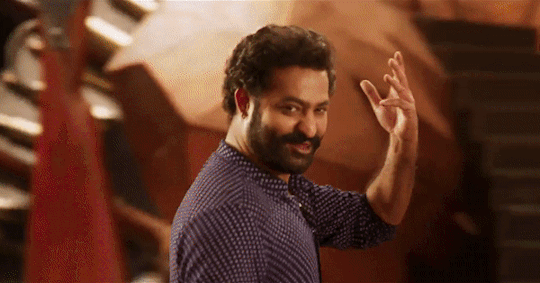
And ok, RRR does have a very imperative call to action but well, look at them, would you not answer???
#decolonialism#rrr movie#rrr#black adam#dc#dc universe#indian cinema#guerrilla I guess#star wars#andor series#andor#marx#marxism#killmonger#black panther#dwayne johnson#response of the opressed#racisim#movie essay#movie gifs#revolution#antifascism
156 notes
·
View notes
Text
@lwoorl Thank you so much for this text! You are absolutely right, and I apologize for my choice of words and approach to this topic.
When I watched this film, as a Latine person but still seeing it from outside the Colombian reality, the first thing I got from it was to associate the scene of the escape and the crossing of the river as an analogy to this imagery of crossing the river as immigration from a place originating from "war" to a place of "peace and prosperity" that I immediately understood as an American discourse without stopping to delve into the context of the Colombian internal conflict, and am terribly sorry for that.
Thank you once again for writing this, and I'm sure to research more deeply (or at least be less incisive with my particular points of view before saying nonsense hahahaha) in the future!!!
"Encanto" and the myth of the Magical Latin America
Well hello again my gorgeous maritacas ✨ Today, we talk yet again about, yes, colonialism.
SOO, I hope I didn't miss the boat on this subject, cause I've been wanting to write about it since I first saw the very first divulgation of Disney's most recent animation movie, Encanto (2021).
I am Brazilian, born and raised in Latin America, and I have been in love with this place since I opened my little dark brown eyes. I spent most of my academic years researching latinex art and culture and history, and one of my deepest passions is our literature. So imagine my instigation when I heard Disney would be making this movie.
You see, in addition to taking place in Latin America and in a country neighboring mine, which would already be a reason for me to be 1000% more intrigued about this, most of the comments and publicity over it followed this line:
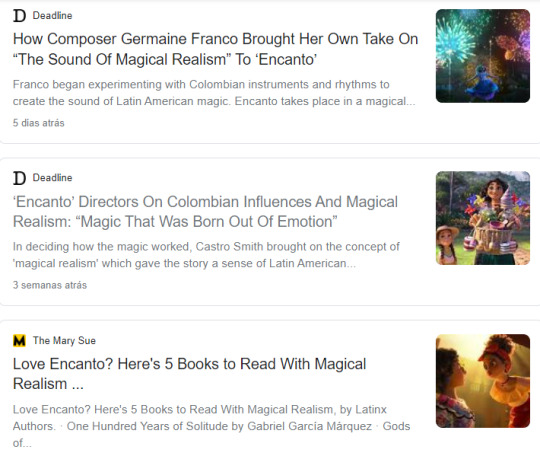
✨Magical Realism ✨
And then I started to worry
And then I watched the movie
Then I got more worry
Because, yes, I know that this is an ongoing discussion on if Encanto is Magical Realism or not, and there're people debating very fairly on both sides, but here I'd like to leave my arguments over why and how I feel culturally obliged to disagree. So, this is my point, and my side, so please don't take anything I say here for fact or go on me for idk, indoctrinate in an argument. But I will be linking a lot of references for you to really see where I'm coming from here, and that place is
NO, ENCANTO IS NOT MAGICAL REALISM
And we really need to talk about it
So buckle up, because this will be long (but necessary, trust me)
SO, I went to read those interviews with the directors and producers of this movie and they said this:
" [...] once Charise joined us, she had such a great grounding and magical realism, that this place, Colombia, which is one of the cradles of that literary style with Gabriel Garcia Márquez, it just made total sense, talking about a family. And a great way to get organic Latin American magic into this film without trying to force it into some European type of magic, that you’ve maybe seen before in other films." (source)
And then, when asked about the differences between "European magic" and "Latin American magic", Charise Castro Smith said:
"Well, I think magical realism is a fast tradition that doesn’t just exist in Latin America. It’s a literature tradition that’s throughout the world. But I think the way we started to think about it and sort of define it within the context of our film, was that it was magic that was born out of emotion. Magic that was born out of character and relationship, instead of something that was like an external force sort of foisted upon the characters in the story." (x)
So, they defined Encanto as "Latin America magic", and defined it as Magical Realism, and that as "magic born out of emotion".
That is not wrong, but that's also not quite right. From what I could get from these interviews, the thing is that, maybe it was wrong phrasing, but I think they mistook Magical Realism for metaphors.
But before I get into that, I have to state that I really liked Encanto. It's fun, it's colorful, and I really think they've done a great job representing how Latino families are structured, and how we relate to our families. I could relate to a lot of the situations in the film on a very personal level, and one of the ways they were able to do that, in my opinion, was through the use of, yes, metaphors.
Because, in this movie, you can divide magic in about two ways:
First, when it's used narratively. That's the case of Bruno's magic, and Dolores', for example. And actually, kudos to Dolores for being one of the biggest narrative tools I've seen in a long time.
And second, when it's used as a metaphor. That would be the case of Luisa's magic, and Peppa's, and etc

See that? That's a metaphor. A very clear one.
And it works just fine. It's good. It's well done. It does a great job passing the point. Magic, here, works as an external representation of internal conflict. Makes us able to get the metaphor and relate to these very personal conflicts without directly addressing them (which would make the movie way, let's say, heavier to watch kkkkkk I'm so funny). So yes, I definitely agree with Castro Smith that Encanto is about magic that comes out of emotion. That's great, 10/10.
But that's not what Magical Realism is.
And I could get into why the whole "magic as metaphor" thing couldn't be considered "European magic" or what even is "European magic" anyway, which would lead me to this whole "let's talk about Christianity" thread, but I'll stick to my current point here (for now)
And for you to properly understand my point here, before getting properly into Encanto I'll have to do some contextualization first, so...
1. MAGICAL REALISM
Let's name the donkeys (Brazilian saying, sorry).
So, the thing Castro Smith said there above, about magical realism not being like, Latin America exclusive? That's absolutely right. We have a huge plurality of great works and authors writing Magical Realism all around the world (one of my favorites is the Mozambican writer Mia Couto, btw). So, for this little contextualization here, I'll quote some lines of another post I wrote about Magic Realism, applied specifically in the context of Brazil (and feel free to check it out here), but which sufficiently covers my point at the moment:
To make matters short, if you never heard of it, Magical Realism is a 20th century genre that portrays "a realistic view of the modern world while also adding magical elements" to it, without this "magic" being perceived as such within this established world.
Matthew Strecher (1999) defines it as:
"what happens when a highly detailed, realistic setting is invaded by something too strange to believe." (source)
So, basically, one of the key points of Magic Realism is the assimilation of this magic as not being "magical" — as we are used to understanding "magic", but rather an estrangement within an apparently common scenario. It is closer to the uncanny than to the fantastical, and the fact that the "commom" people (the characters) within these realistic and common settings do not seem to perceive or assimilate the uncanny as being uncanny, is what creates this feeling of enchantment in these works.
And yes, I know that technically Magical Realism was born in Germany in the 20s, but it really peaked in America Latina. When you think of Magical Realism, the names that probably come to mind are Frida Kahlo, Gabriel García Márquez, María Luisa Bombal, etc. etc. We just nailed it.

And Frida can't let me lie
In his Nobel-winning speech (called The Solitude of Latin America) for his book Cien Años de Soledad (One Hundred Years of Solitude), the Colombian writer Gabriel García Márquez addressed a somewhat poor understanding of his work on the part of European society, who might perceive our Magical Realism as being fanciful and enchanted.
He said:
"I dare to think that it is this outsized reality, and not just its literary expression, that has deserved the attention of the Swedish Academy of Letters. A reality not of paper, but one that lives within us and determines each instant of our countless daily deaths, and that nourishes a source of insatiable creativity, full of sorrow and beauty, of which this roving and nostalgic Colombian is but one cipher more, singled out by fortune. Poets and beggars, musicians and prophets, warriors and scoundrels, all creatures of that unbridled reality, we have had to ask but little of imagination, for our crucial problem has been a lack of conventional means to render our lives believable. This, my friends, is the crux of our solitude.
And if these difficulties, whose essence we share, hinder us, it is understandable that the rational talents on this side of the world, exalted in the contemplation of their own cultures, should have found themselves without valid means to interpret us. It is only natural that they insist on measuring us with the yardstick that they use for themselves, forgetting that the ravages of life are not the same for all, and that the quest of our own identity is just as arduous and bloody for us as it was for them. The interpretation of our reality through patterns not our own, serves only to make us ever more unknown, ever less free, ever more solitary."
I've linked the full speech there above. It's translated to English, but I highly recommend you read the original in Spanish, if you can understand it. Is incomparable
What García Márquez is saying is that there is a subtle difference in the way we Latinos relate to Magical Realism. For us, the fantastic is not there because it is magical or beautiful, or simply as a metaphor. Yes, it is a metaphor, but one so ingrained in our sentiments and experiences that it becomes very difficult to explain or translate to outsiders. The fantastic is actually an European-imposed way of seeing ourselves, because it's how they saw us since the 1500s.
2. THE MAGICAL TERRA INCOGNITA
When Europeans first arrived in our lands, they described Latin America as a land of enchantments. As they were not familiar with the native cultures, native peoples, our fauna and our flora, their way of seeing us was through the lens of the fantastic; lens that they created themselves. If you search online, you will find a series of period maps of the South America depicting magical creatures:
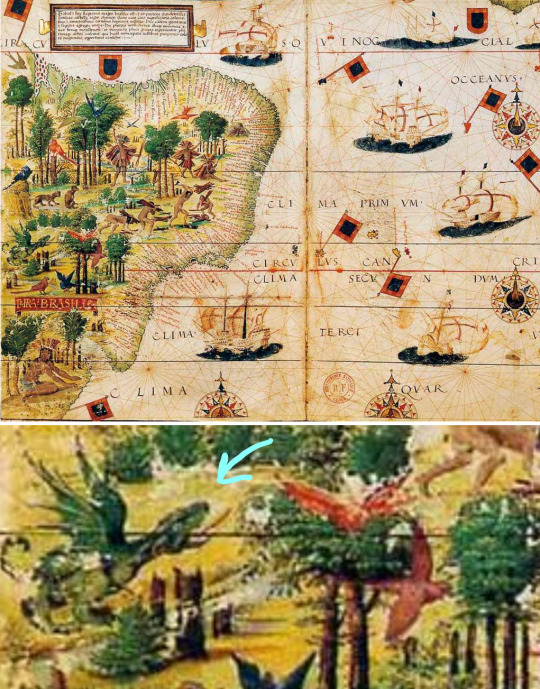
Map by Pedro Reinel and Lopo Homem, named Terra Brasilis, 1519
See the little dragon? That's actually a true story: you see, when the Portuguese arrived, they heard the jaguars roaring in the woods, and thought it was the sound of dragons. They saw the manatees swimming under the river and thought they were mermaids.
As they entered the Amazon River, some boats were attacked by the Icamiabas, warriors of a matriarchal indigenous people in which women went out to fight — and they were spectacular warriors. Seeing these women, the Europeans thought they had arrived on the magical island of the Amazons, of Greek culture. And that's why the Amazon River is now called "Amazon", and that's why the forest is called the "Amazon" forest (source). Because Europeans mystified native peoples.
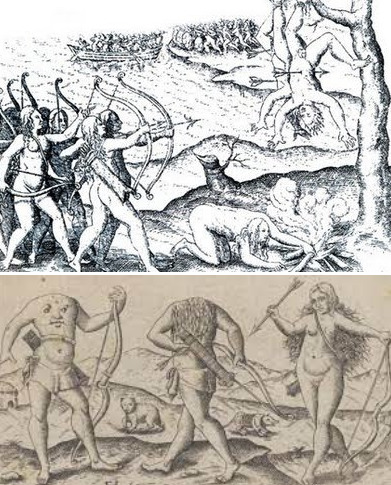
And ultimately, fetishized and bestialized these native peoples.
And that's just like, 3 examples in the specific context of Brazilian colonization process. That's just the tip of the tip of the iceberg.
Regarding that map above, the professor André Reyes Novaes, in his article "Terra Brasilis as Terra Incognita", says (translated by me) that
"At that time, “Terra Brasilis”, as named on the map, was “Terrae Incognitae”, which gave cartographers “carte blanche” (free pass) to fill in the “empty spaces on the map” (Safier, 2009). El Dourado, Ilha Brasil, the Amazon Warriors and many other “myths” occupied the interior of the continent on maps in the period of expansion of the Iberian colonies. [...] Contrasting with the "mythological" interior, the sea appears full of caravels, coats of arms and flags, a space clearly determinated and scratched by the geometry of the orientation lines of the portolan charts. [...] According to Hiatt (2008), the expression terra incognita is today a powerful metaphor, because even in the era of the comprehensive “Google Earth”, it continues to be applied to discuss the relationship between imagination and “unknown” spaces by specific groups. As Wright (1947:72) stated, “if today there is no terra incognita in the absolute sense, there is also no absolute terra cognita”, as we continue to relate to space based on socially produced and shared representations and models." (source)
So, through these records, Europeans created the contrast between European civilizations (organized, mapped, civilized) and native civilizations (bestialized, savage, magical). And that was a very important tool in the domination of our lands. Because when you mystify a people, you dehumanize that people. And it is easier to dominate a dehumanized people.
This enchanted narrative they created actually masked a history of oppression, exploitation, rape and genocide.
And this fantastical way of seeing ourselves ended up being imprinted on us. Magical Realism does not exist to be magical, it exists to express in words, using the language that has been imposed on us, the absurdity of our narrative. It's the way we can translate the reality of our otherwise unbelievable history. As García Márquez said,
"we have had to ask but little of imagination, for our crucial problem has been a lack of conventional means to render our lives believable".
And this resonates even today. Because even after the movements of Independance, Latin America suffered and still suffers from the consequences of colonization, first by Europe, and later by the United States. As Reyes Novaes continues:
"As literal terra incognita, the South American frontiers have gone centuries without being properly explored and represented by European cartographers. As metaphorical terra incognita, these regions continue to be recurrently qualified through imagination and shared narrative in metropolitan centers. Even in the 21st century, the idea of “empty space to be occupied” still populates the imagination about the borders of South American power centers and new mythological “monsters” are represented in these spaces, such as drug-dealers, invaders, smugglers and criminals." [...]
"Considering the metropolitan and coastal vision of many Brazilians, Terra Brasilis remains Terra Incógnita, a relatively "empty" and "uncivilized" space, dependent on public policies formulated from outside. The persistence of this vision in the 21st century is perhaps one of the great challenges for the recognition of our own dynamics and autonomous exchanges existing in border spaces, often imagined as areas to be occupied, protected and colonized by the metropolitan centers." (x)
And by no means this just the story of Latin America. This is the story of Polynesia. Of Southern Asia. Of the African Continent. Of so many nations genocidated by the violence of the colonizer. This mystifications (and later demonizations) of non-European cultures shaped the fantastic imagination of these cultures. That's why I said that Magical Realism found a huge plurality around the world. It represents the imaginary of a colonized nation.
3. MAGICAL REALISM AS A WAY OF PRESERVING AND EXPRESSING COLLECTIVE MEMORY
For this, I'll use García Marquez's work (so often cited to relate to Encanto) as a reference. In his best-known work, One Hundred Years of Solitude, García Marquez weaves the story of generations of the Buendía family, founders of the city of Macondo, over 100 years.
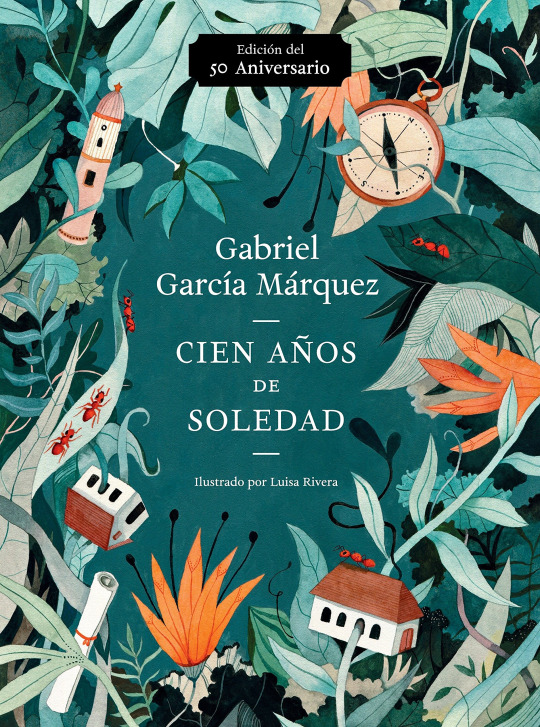
After the book's release, not few managed to find, in Macondo, an analogy for Latin America itself, and the events that surround the characters in the book, mirrors for events that marked our own history.
The metaphors that appear throughout the book, not so much metaphors for personal feelings, are closer to metaphors to express the feeling of an entire nation during actual events, as he said in his speech, of unbelievable, "unbridled reality".
Look at this excerpt:
"Although in the months that followed they reinforced the grave with walls about it, between which they threw compressed ash, sawdust, and quicklime, the cemetery still smelled of powder for many years after, until the engineers from the banana company covered the grave over with a shell of concrete." (source, p. 69)
At a certain point in the book, an American arrives in Macondo and, settling himself next to a train line, starts an innocent banana plantation. Later, his business grows and he starts a banana company, which takes over Macondo and suddenly, the entire production of the city consists only of bananas. Macondo no longer produces anything other than bananas, which are quickly loaded into huge train cars that carry these bananas away. The city is then taken over by a banana plague, and as the above passage describes, eventually even the cemetery is covered by the banana company.
Now, if you have ever studied anything from Latin America, you will probably immediately associate this with the famous United Fruit, a real multinational known throughout the world for creating the concept of the Banana Republic and for changing the political and economic directions of an entire continent (ours).
It's like a scheme:
Basically, using local (and inhumanly cheaper) labor, they specialize in the cultivation of a single commodity, produce that commodity on a large scale (thus ending any family farming systems that might exist and alienating production and the local market) and then export this commodity abroad at ABSURDLY lower prices than other markets. That's what happened with the banana. This type of system forces a country to remain in underdevelopment, and this was a large-scale project carried out in Latin America by the United States. And we reap the "rewards" of that in our industry and economy to this day.
And then García Marquez writes:
“Look at the mess we’ve got ourselves into,” Colonel Aureliano Buendía said at that time, “just because we invited a gringo to eat some bananas.” (p. 114)
Do you know what happens next? The exploited workers revolt against the banana company, and they are all machine-gunned by the American military. Women and children too. After managing to escape with his life and return home, José Buendía counted about three thousand dead. And when he goes and tells all this, horrified, to the first person he meets, do you know what that person says to him? She says "What are you talking about? There weren't any dead".
"The official version, repeated a thousand times and mangled out all over the country by every means of communication the government found at hand, was finally accepted: there were no dead, the satisfied workers had gone back to their families, and the banana company was suspending all activity until the rains stopped." (p. 151)
Now you go, and you Google "United Fruit Banana Massacre" or just "Banana Massacre". That's the Realism in Magical Realism.
Through a prosaic narrative, what García Marquez is doing is documenting historical events. Trough the narrative of One Hundred Years of Solitude, García Marquez told the story of his own land.
And the banana case is clearer to understand, but these historical relationships run through every aspect of the book. Take this other example: Right at the beginning, the narrative shows the patriarch of the Buendía family, José Arcadio Buendía (and his wife Úrsula Iguarán) guiding a group of people into the virgin forest in search of a place to build a village, and then,
"When they woke up, with the sun already high in the sky, they were speechless with fascination. Before them, surrounded by ferns and palm trees, white and powdery in the silent morning light, was an enormous Spanish galleon. Tilted slightly to the starboard, it had hanging from its intact masts the dirty rags of its sails in the midst of its rigging, which was adorned with orchids. The hull, covered with an armor of petrified barnacles and soft moss, was firmly fastened into a surface of stones. The whole structure seemed to occupy its own space, one of solitude and oblivion, protected from the vices of time and the habits of the birds. Inside, where the expeditionaries explored with careful intent, there was nothing but a thick forest of flowers." (p. 12)
They find a Spanish galleon. Intact. Filled with flowers. They were for the first time clearing a virgin forest, making their way, and when they arrive in the land that in the future would be their home, they discover that Spain was already there, craved in the stone soil. Here, the galleon can be interpreted as representative of the Spanish domination, which is embedded in the imagination of our lands by the invention of the narrative of a "discovery" that completely erases the history that existed here before the arrival of Europeans.
But if you are not familiar (or at least know about it) with the collective feeling of the solitude of being the result of an erased history and memory, the only thing you'll take from this scene is how beautiful it is.
And as I said before, Latin America is not the only one to use Magical Realism to translate a fantasized reality. The book Terra Sonâmbula (Sleepwalking Land), by the Mozambican writer Mia Couto (I just love this author so much), is another great example of what I'm talking about. And I won't go into this otherwise it would be very long, but just go and read it. It's amazing.
So, I think you got the hang of the ideia by now.
But what does all of this have to do with Encanto?
4. "LATIN AMERICA MAGIC"
Now that you've been covered up with all this historical contextualization and some examples above, I'll repeat what I said at the beginning: to me, Encanto is not Magical Realism. And this is due to two factors:
The magic is perceived as magic within the movie's stablished universe
The magic in Encanto is always individualized
Let's start with number 1. As I said there above, there isn't exactly a rule on this particular aspect, but it's a general consensus that for Magical Realism to happen, you can't have phrasings like "this is magic!" or "they did magic!" within your universe. As Figueiredo points out (and yes, I'll put here yet another source here, but this is only to stablish my point using more then one academic source so you don't think I'm taking this off my ass (another Brazilian saying, sorry again), in Magical Realism
"...the supernatural is presented in a realistic way, as if it doesn't contradict reason, and there are no explanations for the unreal events presented. There is no reference to the mythical imagination of pre-industrial societies, as if the author, not concerned with the reader, exercises full freedom of creation. Magic refers to inexplicable, prodigious, or fantastical occurrences that contradict the laws of the natural world, and there are no convincing explanations in the text for their presence. It differs from the fantastic in that the narrator is not altered, intrigued or disturbed by this reality." (source, translated by me)
You can see that in Sleepwalking Land, where the character Kindzu sees his brother turn into a rooster in front of him and his reaction is closer to "well that sucks, guess we gonna put him in the chicken coop now" than some astonishment.
Or in O Tempo e o Vento (The Time and The Wind, a Brazilian novel), which tells the story of generations of a family in which the fate of women is to spin, cry and wait, and where, on the return to his wife, a man ends up arriving 50 years late.
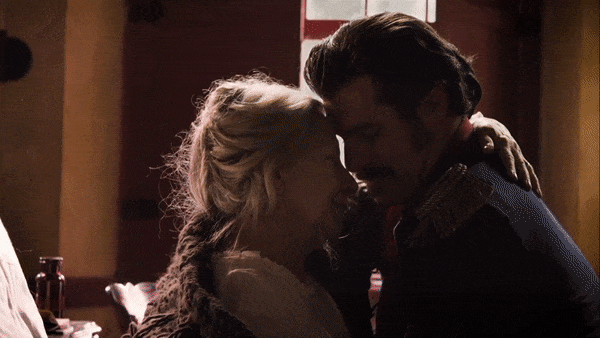
And he finds her an old woman, of course, waiting.
You can see that in One Hundred Years of Solitude, when the city is attacked by a plague of oblivion and there's no fuss over it. Or when it rains for 4 years and the old people just decide to wait to die in the drought, because they don't want to die wet. Or when a pig-tailed baby is literally carried into the earth by countless ants and no one bats an eye. Or when Remedios the Beauty had to be isolated from any contact with foreigners because her scent was so seductive and so strong that in one incident, upon seeing her naked, a man's blood turned into oils soaked in her perfume, torturing him even after death. Or when, after the death of José Arcadio Buendía, the city was covered with yellow flowers that fell from the sky, and the only reaction was that they had to mobilize people to clean the streets so the funeral procession could pass by.
In fact, the only scene in which a character in the book is truly astonished by something is when, for the first time, José Arcadio Buendía and his son Aureliano see ice.
"MANY YEARS LATER as he faced the firing squad, Colonel Aureliano Buendía was to remember that distant afternoon when his father took him to discover ice." [...]
“It’s the largest diamond in the world.”
“No,” the gypsy countered. “It’s ice.”
José Arcadio Buendía, without understanding, stretched out his hand toward the block, but the giant moved it away. “Five reales more to touch it,” he said. José Arcadio Buendía paid them and put his hand on the ice and held it there for several minutes as his heart filled with fear and jubilation at the contact with mystery. Without knowing what to say, he paid ten reales more so that his sons could have that prodigious experience. Little José Arcadio refused to touch it. Aureliano, on the other hand, took a step forward and put his hand on it, withdrawing it immediately. “It’s boiling,” he exclaimed, startled. But his father paid no attention to him. Intoxicated by the evidence of the miracle, he forgot at that moment about the frustration of his delirious undertakings and Melquíades’ body, abandoned to the appetite of the squids. He paid another five reales and with his hand on the block, as if giving testimony on the holy scriptures, he exclaimed:
“This is the greatest invention of our time.” (p. 8-15)
CAN YOU FEEL THE CHILLS WHILE READING THIS? CAUSE I CAN
Magical Realism doesn't enchant us because it is magical. It enchant us because it is so raw, and crude, and so painfully real, that we feel our souls tearing apart when we come in contact with it. Just take a look at any Frida's paintings and you'll get what I mean
In Encanto, however, the "magic" is definitively perceived as magic, and it's often pointed out by MANY characters throughout the story. So, to me, that kind of breaks the Magical Realism thing.
Because it just looks like a "magic as a metaphor" situation, not anything out of the ordinary for a Disney movie. For example, how are any of the magical situations in Encanto different from, say, the ones in Beauty and the Beast? Really, it's pretty much the same idea, magic as a metaphor. And a magic house.
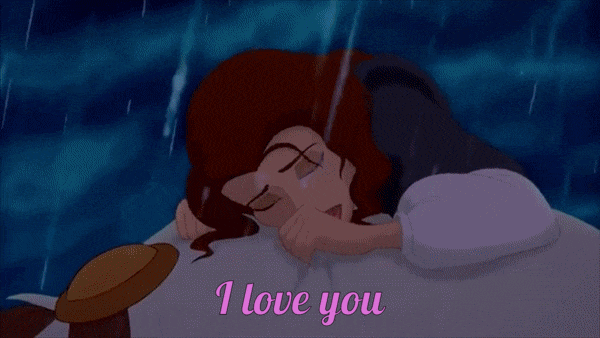
You even get the emotion magic going on and all
And that's super ok.
I love Disney magic. Everybody does.
So why call it differently just because it's set on Latin America?
AS FOR NUMBER 2
This might seem more of a personal opinion, and maybe it is, but this was actually one of the things that bothered me the most in this whole "Encanto is so Magical Realism" thing.
Because, as I spent 90% of this post explaining, Magical Realism in Latin America has very specific contours that are the result of centuries of troubled history. To ignore the social, historical and, above all, political undertones that the Latin works of Magical Realism have, is to ignore all the effort that this movement had in reclaiming the fantastic narrative of our own existence.
Is to ignore all the power we got by taking away from the colonizers the right to see us as "enchanted" or "magical".
And again, maybe this is a personal feeling of mine. But I can't see a work in which magic is used in such a personal and individual way by the characters as Magical Realism. As a metaphor for overload, or for personal conflicts, or for intergenerational trauma, or for singular heartache. Don't get me wrong, I loved the way Encanto created these metaphors. And they are great. I just can't fit it into everything I said above.
And I know the film DOES represents a reference to our troubled history and violence through the story of Abuela Alma. And again, this may be a personal opinion, but although I was deeply moved and cried the whole time, I don't think it was enough to frame this scene as "social criticism", or as something political.
In fact, I think this scene relates much more to the children and grandchildren of immigrants who had to leave Latin America for violent and inhumane reasons, than to us who stayed here. And perhaps that was the purpose of the film, to speak to the Latino families who were forced to diaspora. But then we are talking about another story. Not Colombia's.
I can't disassociate Magical Realism from politics, and I don't think it should be done. Because when you strip the Magical Realism from the political and historical and social contexcts, the only thing left is the "magic". And that's giving back the power to the colonizers. We are not "magical". Latin America is not "magical".
And I think that when you strip the symbols created by García Marquez from their original contexts, so carefully stitched together by him, you vastly impoverish his work.
For me the best example of this is the yellow butterfly.
The yellow butterfly ended up turning into something, apparently. Not only in Encanto, but in more than one "Latin" recent work I've seen some mention of butterflies that were clearly based on One Hundred Years of Solitude (yes, All The Crooked Saints, I'm looking at you)
And you can see that there is a direct relationship between the yellow butterflies in Encanto and the yellow butterflies in One Hundred Years of Solitude.
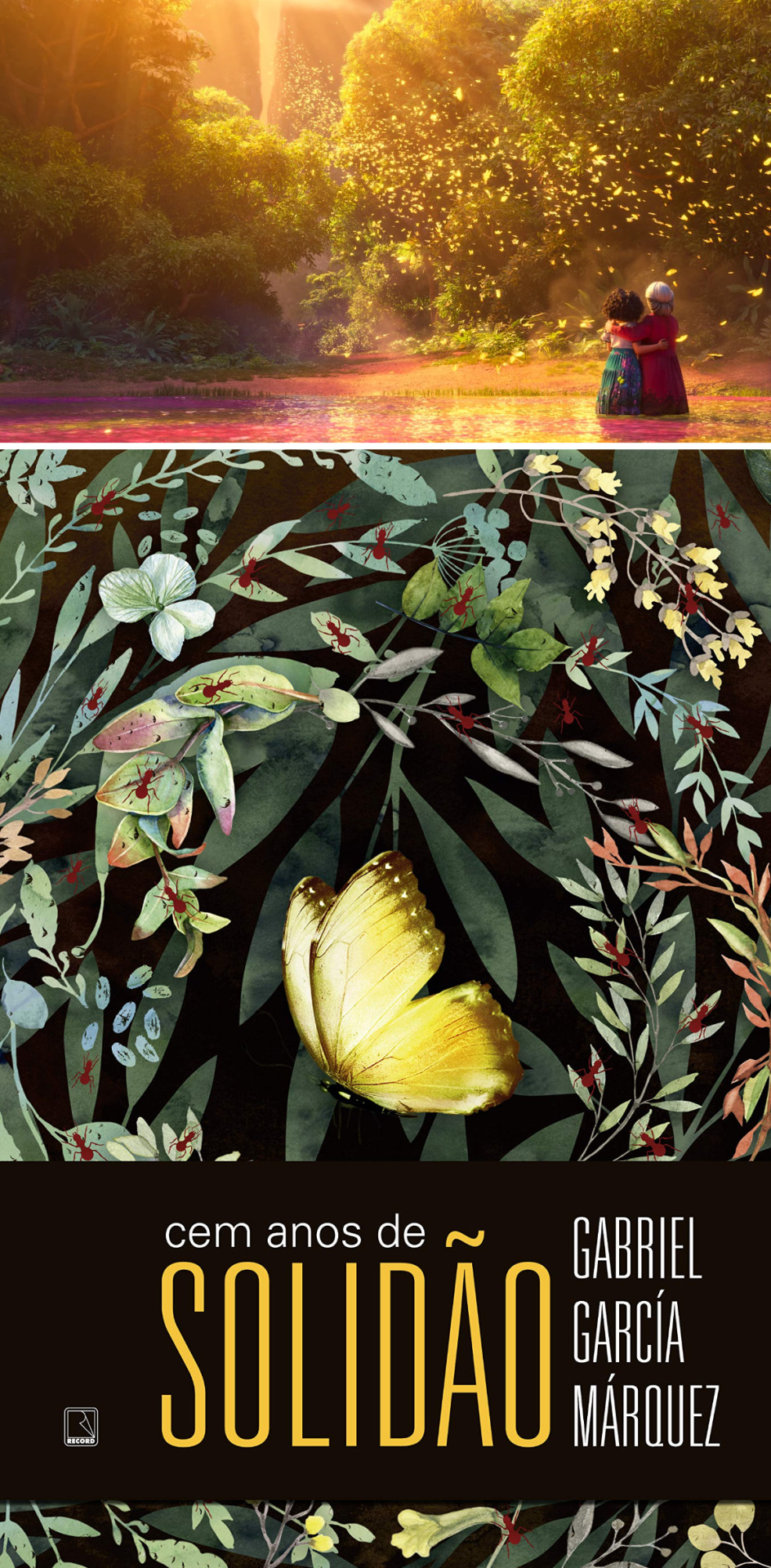
And while there's no way to know what was going through García Marquez's head when he wrote these butterflies (only that yellow butterflies populated his grandparents' house during his childhood), the yellow butterfly ended up becoming a symbol of Latin Magical Realism.
Which is beautiful. But if you read the book, you'll see that they only appear in the narrative of the life of Renata Remedios (Meme), great-great-granddaughter of José Arcadio Buendía and Úrsula Iguarán. More precisely, the butterflies would only appear around Mauricio Babilonia.
"It was then that she realized that the yellow butterflies preceded the appearances of Mauricio Babilonia. She had seen them before, especially over the garage, and she had thought that they were drawn by the smell of paint. Once she had seen them fluttering about her head before she went into the movies. But when Mauricio Babilonia began to pursue her like a ghost that only she could identify in the crowd, she understood that the butterflies had something to do with him. Mauricio Babilonia was always in the audience at the concerts, at the movies, at high mass, and she did not have to see him to know that he was there, because the butterflies were always there." (p. 141)
The passion of Meme and Mauricio is one of the most detailed and poetic of the book. When the relationship is forbidden by Meme's mother, Fernanda, the two start to see each other in secrecy. Mauricio spends every night sneaking into Meme's quarters. And as, consumed by passion, she lives for the moment she will meet him, she waits for him lying on the bathroom floor, naked and burning with love, surrounded by scorpions. And the first sign of his arrival are the yellow butterflies coming through the window and infesting the house.
There's a line, when they're meeting at the cinema, that says:
"Meme felt the weight of his hand on her knee, and she knew that they were both arriving at the other side of abandonment at that instant". (p. 142)
The thing is, the two are lonely. And the more they sink into each other, the lonelier they get together. After Mauricio's death, the butterflies start to follow Meme, who drowns in lethargy. The yellow butterflies are, in the book, the symbol of the relationship of these two characters, who drowned their loneliness in each other's carnality. It's an intense, and carnal, and sensual, and painfully shallow relationship. And most of all, it's incredibly sad.
"Aureliano recognized him, he pursued the hidden paths of his descent, and he found the instant of his own conception among the scorpions and the yellow butterflies in a sunset bathroom where a mechanic satisfied his lust on a woman who was giving herself out of rebellion" (p. 200)
This is what was translated into the feeling of the solitude of the Latin America. Not by García Marquez himself, but by later interpretations. When I think about it, I always picture it as the feeling of the moment when, every night, Meme sees the first yellow butterfly coming through the window, and she can feel that in her gut.
And now you tell me,
why would anyone consider using this symbology in a Disney movie?
And even more, to use as a symbology of reconciliation and protection and family love? And...???
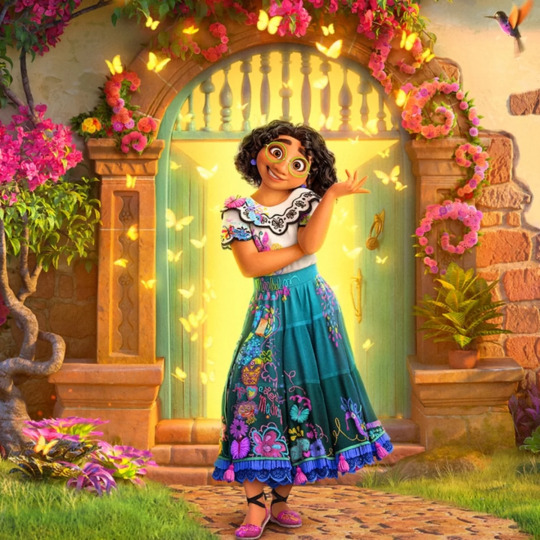
Disney my beloved??????
So, yeah, I think this movie had a lot of beautiful references to García Marquez, but taken so far from the original contexts and in such shallow ways that to me it felt more like they researched and saw that apparently yellow butterflies represent Latin Magical Realism and García Marquez and thought "wow this is lovely let's totally use that look how beautiful this is" because it looked "magical".
SO IN CONCLUSION
I like Encanto. This post is in NO WAY an attack on the film, or the Latin representation of the film. In fact, I think Encanto does a really great job at it (and as a light-skinned latina, I can stand by that very deeply).
But the statements about the magic of this movie, and the divulgation around it, and the way the producers of this movie have labeled it and approached all of this... Idk. I don't know why they felt the need to place Encanto as belonging to or inspired by Magical Realism, rather than simply telling a story that stands on its own, and happens to be set in Latin America.
I don't think the homages they paid to García Marquez were wrong or offensive in any way, in fact I thought they were all nice. I thought the yellow butterflies were beautiful, and yes, they did ended up becoming a symbol of Colombia, whether this is based on their original meaning or not. I am not complaining about the fact that they were there. What bothers me is that label. This justification that the magic of Encanto would be, somehow, different, because it was latina. That we'd have a magic that'd be different from the "European Magic".
And that bothers me even more because, I was curious enough to research to see if I was missing something, and I couldn't find ONE Latin story or legend that mentioned a magic house, for example. In Brazil we have some stories that take place in magical houses or castles (my favorites when I was a kid were "The Devil's Godchild" and "The Black Bird"), but all of these are adaptations of originally European tales. That arrived here with the European colonizers. This idea of a magical house with lots of doors and rooms bigger than the outside and fantastic things inside each of them is INCREDIBLY European. Based on European fairy tales and fables.
Aside from the fauna and flora and architecture and clothing and family dynamics the movie depicted wonderfully, there was NOTHING in the magic of Encanto that referenced or translated any folkloric magical elements of Colombian culture. I saw nothing remotely close the the La Madre de Agua, or a patasola, or a candileja, or Las Brujas de Burgama, nothing.
Why, when Disney makes a movie based in some European country, they choose fairy tales and stories from those countries to adapt, but in Latin America they ignore our stories? The legends of the native people, indigenous people, inland culture, anything?
Curious, isn't it?
But anyway, back on track. Since they didn't take an already existed tale from here, guess they thought that Magical Realism would be a good way to convey that. But they kinda didn't do that? As I said, I don't think Encanto is Magical Realism.
And honestly, if they had just made up a story that made sense and was respectful to our culture, and just placed it in Latin America (like The Emperor's New Groove, the most flawless Disney movie ever made), I think I would have enjoyed it a LOT more. But to me, it just felt like they were trying to make the whole thing about Magical Realism, without delivering it properly.
So they just made Latin America magical for the gringo eyes again.
Cheers.
SO YEAH, these were my thoughts on the subject!!! Please don't take any of it as any kind of personal attack on the people behind the movie, if there's any blame I'm more then happy to just put it on Disney Company (but we all agree on that, I think). I just wanted to tell a little of our history and explain why Magical Realism means so much to us. And you are totally free to have whatever opinion you do on this!!! RISE AND SHINE
And, as always, thank you so, so much for reading!!! ❤
301 notes
·
View notes
Text
Interestingly, Amazon's Rings of Power issues can actually be summarized into its costumes
OR: Why Númenor cannot really look like Rome
Hello again, I YET LIVE! 💃
Soo, I haven't been able to write in ages cause since my graduation I've been in full monday to saturday 9AM-7PM proletarian mode, and I am a brazilian living in Brazil during one of the biggest attacks on democracy that we as a nation have experienced since the end of the military dictatorship 37 years ago aka Bolsonaro which is as nice as a kick in the nose, BUT FOR THIS SPECIFIC CASE, I, like palpatine, HAVE RETURNED.
but I'll make this one quick tho I swear (kkkkkkk)
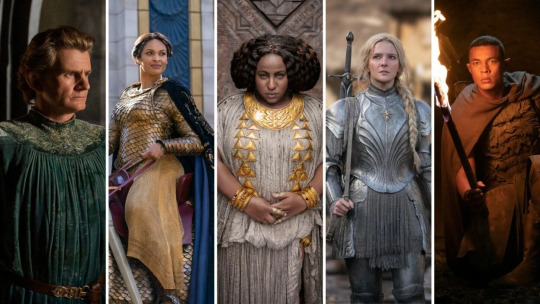
I'm gonna talk about fictional characters' clothes.
And before I start, a brief disclaimer, I HAVE NOT FULLY WATCHED RINGS OF POWER YET. In fact, I've only watched the first three episodes. First because I didn't have the time, and second because honestly if they wanted to keep my attention longer they should've tried harder to make me care about any character other than my little boy Arondir, which they didn't so here we are.
But seriously, I'd like to make something very clear, I have absolutely no rights to tell you if Rings of Power is good or not, because I haven't watched it in its entirety, simple as that. That's not my point here, so if you liked this show, if you were moved by it, if it brought you back to a happy and safe place in Middle Earth, I'm glad, because that's great. We are living in very difficult times worldwide, and I will be the last person to condemn someone for consuming media that makes them happy and comforted. My issues here with it lies in a much simpler department, and that's what I'll be going on about.

✨ CHEAP COSTUMING ✨
And seriously, as I've said before, haven't watched the show, so I'm not even going to get into the merits of addressing good costuming in the narrative field, or the character development field, or anything like that – and you can easily find A LOT of videos and articles by much more qualified people than me covering these topics in detail. I'd just like to point out the problems with these costumes in the most basic way possible: they're the laziest thing I've ever seen since the end of the Night King in that 8th season.
And honestly that's embarrassing.
So look, I wouldn't be so picky if this were literally any other fantasy production.
While I fully understand and agree that any work must be able to stand on its own, and be amenable to analysis and criticism as a unit short of "necessary" contextualization, I also believe that in certain cases this separation is not, and should not be, possible – and in this scenario, this is the case of the construction of an universe. When you transfer this to the media field, it translates into the construction of the imagery of a universe, and for me, in my opinion, in these situations you cannot analyze each work of a same universe separately.
They need to dialogue with each other, and in the case of imagery, they need to have visual connections.
And one of the most powerful ways to convey to an audience that yes, this work takes place in this particular universe, is through costuming and characterization.
It is as if someone asked you to go to the market to buy lemons, and then showed you what a lemon is, so that when you arrive at the market, you can identify the lemons, and differentiate them from, for example, an orange, or a lime, or a tangerine. Right?
Rings of Power did not understand that.
Pray tell me, can you differentiate the lemons from the limes here?
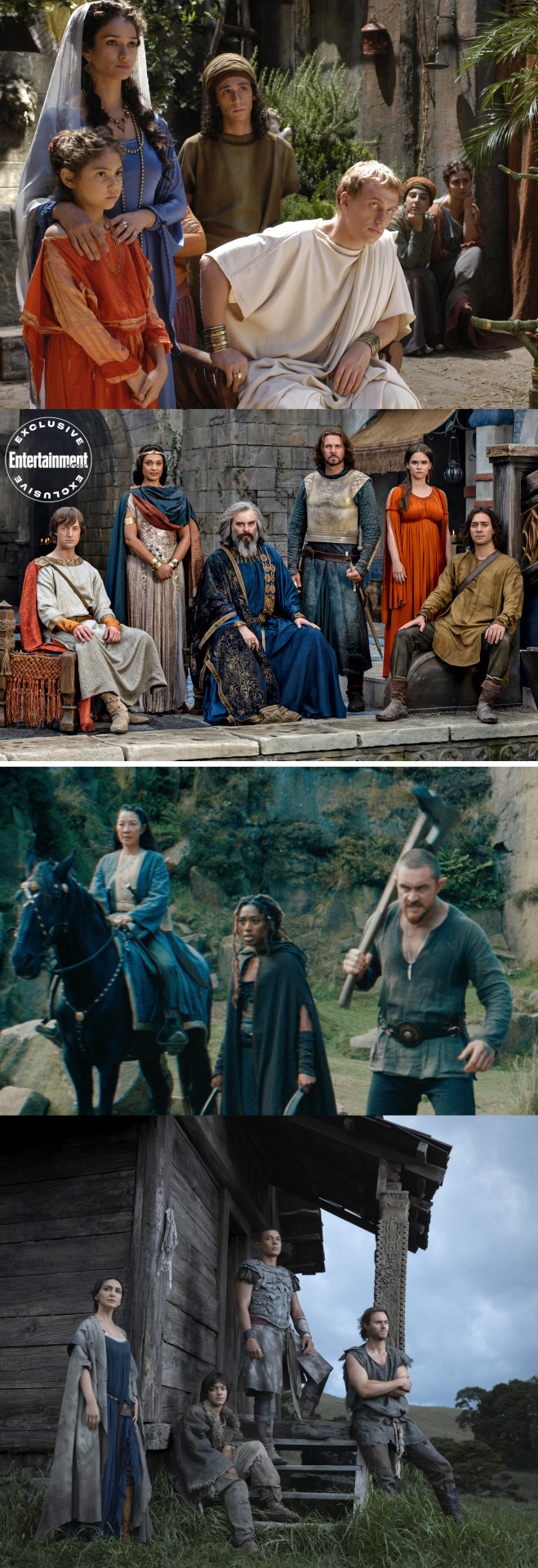
Really, can you?
If you didn't already know these series, would you really be able to point out for sure which is which? Or, more importantly, which universe are they a part of? And, even more importantly, if you didn't already know, could you point out to me which of these are Lord of the Rings?
I couldn't.
And actually, there's inherently no problem for you to have a fantasy series with generic fantasy costumes (I, myself, particularly prefer it when the costumes aren't generic, but there are a number of shows or movies where the costumes might not be the most distinguishable thing in the world, but work really well in that context and are overall great costumes. That's absolutely fine). But in this specific series, it is very much a problem.
Because Lord of the Rings is not generic.
Even if they were creating the first ever visual adaptation of Tolkien works, I would already have rave reviews. But worse than that, they're putting themselves in a universe with imagery that not only already exists but is METICULARLY well established by the Peter Jackson films.
And what's interesting to me isn't even the fact that they're different from the costumes in the Peter Jackson movies. Depending on how it was done, I could at least respect the decision to create a completely fresh identity (provided it could dialogue with the previously established one, and with the worldbuilding created by Tolkien in the source material). What I find interesting is that in pretty much every costume, I can see where they got their inspiration from. And they are all the laziest possible.
Take Númenor for example. It's as if they looked at a summary of what Númenor is in Tolkien's writings and thought "a colonizing nation and mighty empire that existed before a society that years in the future would be represented as medieval inspired = Roman Empire". And/or Macedonian/Byzantine, for I can see a mixture of elements of those in many of the costumes and settings.
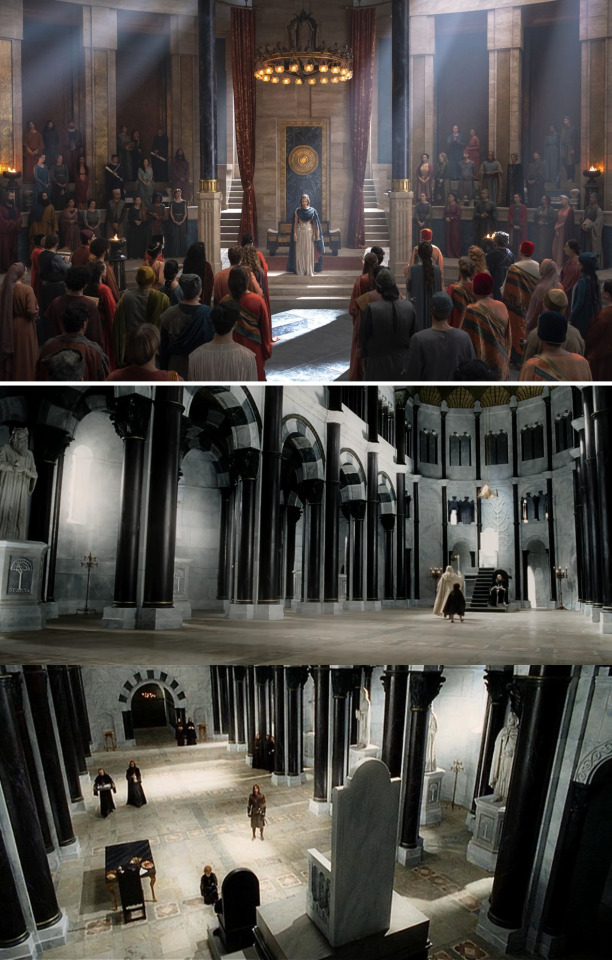
Even in the setting of the scenes: Compare the throne room of Númenor with that of Gondor, the latter with rounded columns and elliptical arches and a direction that always showed the room diagonally – from the corners, or behind the throne, to create an effect of disharmony, emptiness and decay (in almost every scene, the columns seem to be a little slanting). In contrast, the hall of Númenor is presented in the most squared and geometric way possible: the columns are straight, the scene is perfectly framed in the center, perfectly mirrored, and all the lines are either parallel or perpendicular, indicating straightness, balance and patterning – very Hellenic.
The association seems to be very obvious at first glance. The Hellenic empires are by far the best-known and most perpetuated example of empire in the mediatic imaginary of our Western culture, so it's a very easy way to convey to us, the audience, that these guys are your standart big "advanced" and colonizing civilization that see themselves as "closer to the gods" or something. And ok, fine.
I don't think the concept of being aesthetically inspired by the Romans would be anywhere near bad, were that any case other than Tolkien's universe.
For example, within the imagery created by Tolkien I would much rather see a Celtic inspiration for Númenor than a Roman/Macedonian one (since we're talking about great cultures that preceded Christian kingdoms in Europe), simply because this Roman aesthetic, while efficient in giving us the most basic impression possible about these people as lazily quickly and efficiently as possible, inevitably ends up pulling us by the throat out of the immersion of Middle Earth. It simply breaks it.
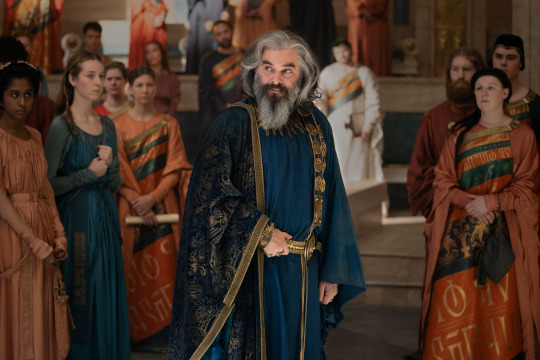
Like, really tho, would you bait an eye on this an call it Middle Earth??
And ok, fine, I know the Celts aren't the first association we make with "great nation" (and actually they were colonized and genocidated by the Romans so there's that lovely layer) BUT THE THING IS THAT MIDDLE-EARTH IS NOT THE REAL WORLD. And yes, I know that Gondor can easily be associated, yes, with Rome and the Byzantine Empire, and that Númenor is very much Atlantis. But one thing is contextual and narrative inspiration, another is aesthetic inspiration. And it's aesthetics I'm talking about here. If the two always went hand in hand, then in House of the Dragon we would have to see the Targaryens walking around 24/7 in full roman attire.
That's what I mean when I call the costuming lazy. Because it's much easier for you to make a visual association than to actually build one through writing and narrative construction. And that's why I say that for me this is a reflection of the whole series. They seem more focused on making checklists in a basic formula than showing us, you know, Tolkien.
"Oh but Númenor is clearly based on Atlantis, you said so yourself", technically, yes (and Tolkien wrote of Númenor as Atlantis in several of his letters), but primarily, Númenor is simply a big island that was swallowed by the sea, and this mythology is by no means unique to the Greeks. In adaptation, Númenor could be based for example on the Cornish "Lyonesse", or on the Breton "Ys", or even the Gaelic "Hy Breasail". Atlantis is just the most well-known version of this myth (to put it simply), and therefore the one that would be most quickly recognized, and therefore the easiest to pull off.
In fact, if one were to delve deeper into the meaning of the fall of Númenor (and there one can even extend to the greater meaning of all these mythologies entering 100% in the field of the collective unconscious and Ginzburg-ish tracks), to which the Tolkien refers to as the second fall of man, with "its central theme is (inevitably, I think, in a story of Men) a Ban, or Prohibition" [x]. The Numenoreans desired immortality, and for their pride they were banished, forbidden from entering the Undying Lands of Aman – which, essentially, comes very close to the idea of the Fall embodied by Christianity.

Satan's Fall From Heaven, illustration by Gustav Dore for John Milton's Paradise Lost
As Tolkien himself said in his 1951 letter to Milton Waldman:
"I dislike Allegory – the conscious and intentional allegory – yet any attempt to explain the purport of myth or fairytale must use allegorical language. (And, of course, the more 'life' a story has the more readily will it be susceptible of allegorical interpretations: while the better a deliberate allegory is made the more nearly will it be acceptable just as a story.) Anyway all this stuff is mainly concerned with Fall, Mortality, and the Machine. With Fall inevitably, and that motive occurs in several modes." [...] "This desire is at once wedded to a passionate love of the real primary world, and hence filled with the sense of mortality, and yet unsatisfied by it. It has various opportunities of 'Fall'. It may become possessive, clinging to the things made as 'its own', the sub-creator wishes to be the Lord and God of his private creation. He will rebel against the laws of the Creator – especially against mortality." Letter to Milton Waldman, 1951, p. 2 – you can read it here
And directly about Númenor, (if you wanna go full nerdy here), he stated that
"The Downfall of Númenor, the Second Fall of Man (or Man rehabilitated but still mortal), brings on the catastrophic end, not only of the Second Age, but of the Old World, the primeval world of legend." [...] "Their reward is their undoing – or the means of their temptation. Their long life aids their achievements in an and wisdom, but breeds a possessive attitude to these things, and desire awakes for more time for their enjoyment. Foreseeing this in pan, the gods laid a Ban on the Númenóreans from the beginning: they must never sail to Eressëa, nor westward out of sight of their own land. In all other directions they could go as they would. They must not set foot on 'immortal' lands, and so become enamoured of an immortality (within the world), which was against their law, the special doom or gift of Ilúvatar (God), and which their nature could not in fact endure." "There are three phases in their fall from grace. First acquiescence, obedience that is free and willing, though without complete understanding. Then for long they obey unwillingly, murmuring more and more openly. Finally they rebel – and a rift appears between the King's men and rebels, and the small minority of persecuted Faithful." Letter to Milton Waldman, 1951, p. 7 - 8
So like, I think there was a lot of room to go around here. There was absolutely no need to deviate from the already existing aesthetic (from the movies) in order to evoke a counterpart in the real world – to me, this just impoverish interpretations, discussions and overall the whole work. A great example of this is the Numenorean symbol.
In the books, the main symbols of Númenor (if I'm not mistaken) are the tree of Númenor, the eagle and especially the five-pointed star.
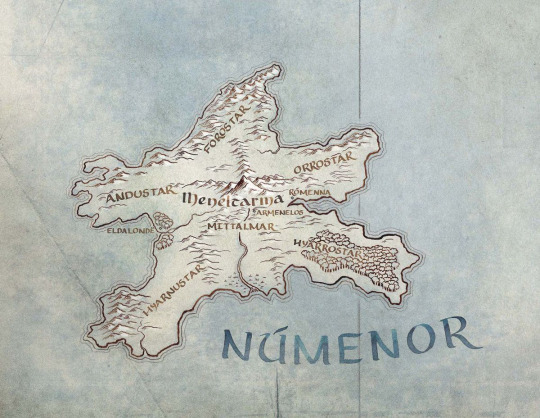
The island (or continent) on which Númenor was located was in the shape of a five-pointed star, and they were a nation that relied largely on astrocartographies for their navigations.
So you would assume that we would see these symbols on the series, right? Five-pointed stars and trees and stuff like that, right?
Wrong
They gave us this:
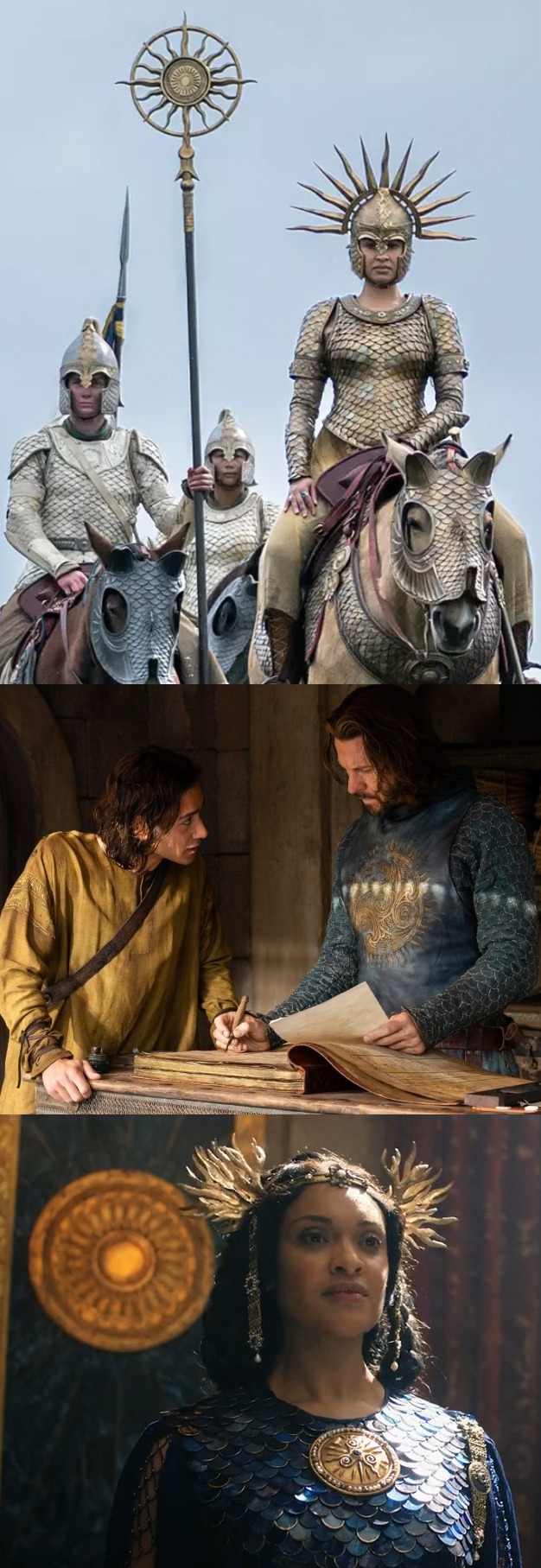
The golden Sun
Nowhere in Tolkien's writings (to my knowledge) does he compare Númenor with the sun. I know that technically the sun is a star, but these are completely different archetypal symbols. Tolkien's greatest association with the sun is in relation to Anar, and the Two Trees (and perhaps one could even make an association about how in Middle-Earth the sunlight is "inferior" to the original light of the Two Trees as a metaphor for like the Numenoreans try to persue immortality and emulate the elves, but honestly it's a very long stretch).
(being fair, they did try to play with some celtic sun symbols there, but it ended up just looking out of place)
The main association with the golden sun in our western culture (excluding indigenous cultures, Mesoamerica and South America, we have our own relationships with the figure of the sun that does not enter here at all) is with the Panhellenic symbol of the Macedonian Sun, or Vergina Sun.
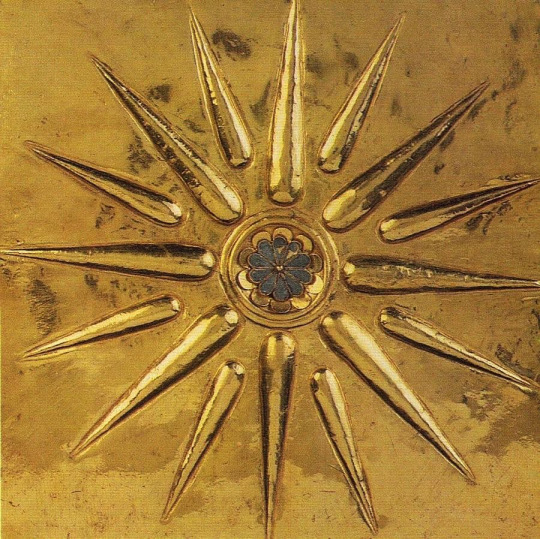
You can see the resemblance very clearly, especially in that golden banner in the first image
And there is, again, no problem with you drinking from real world inspired sources to build a fantasy world (every fantasy world is an analogy to the real world and etc etc). But if you're going to make direct visual associations with real-world elements, those associations must be very well thought out and very well planned. Otherwise, as happened (in my opinion) with the golden sun of Númenor, you end up breaking the immersion of a visual universe that, if it drink from some source, is not the one you used.
Famously, the great inspirations for Tolkien's work were Germanic, Celtic, Finnish, Slavic, Greek and Norse language, folklore and mythology, especially the Icelandic sagas and ultimately the basic christian structures. [little sources 1, 2 and 3 if you wanna know more, or you can go to the first page of Tolkien's letter to hear it from the man himself]. You even have this whole diagrams going on about it:
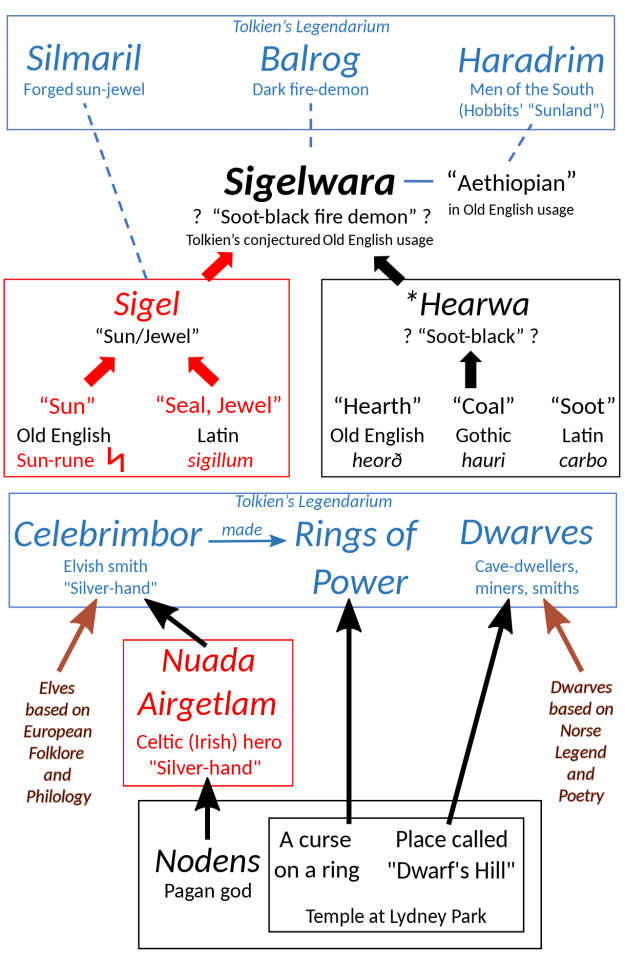
This is the foundation of the universe, this is the fountain you will want to drink from. And that's the source that Ngila Dickson drank from to make the costumes for the Lord of the Rings movies.
Compare for example Elendil's costumes from the The Fellowship of the Ring (2001), and then from Rings of Power (2022).

Can you see where I'm coming from?
Ngila Dickson's take on Elendil not only fits perfectly into the setting of this world being presented to us, but it also manages to create a unique and recognizable aesthetic for the character (and therefore, for his people).
When, in the third film, we see Aragorn'scoronation, it is not difficult to recognize if not the armor, but at least Elendil's royal crown.
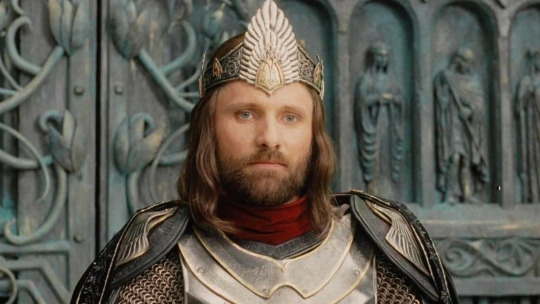
Dickson plays not only with historical inspirations but mainly with associations within the visual universe of the films: in the crown alone, you can see inspirations taken from the architecture of Gondor itself: the crown aesthetically resembles the city. She's not referencing the real world, she's referencing Middle Earth.
In Rings of Power, Elendil only looks Byzantine.
And that's just lazy.
Also, for some reason I didn't get, the elves also wear roman elements? Like, what's the point of that? Are the Numenoreans then trying to copy the elves in some way, or…? Idk???
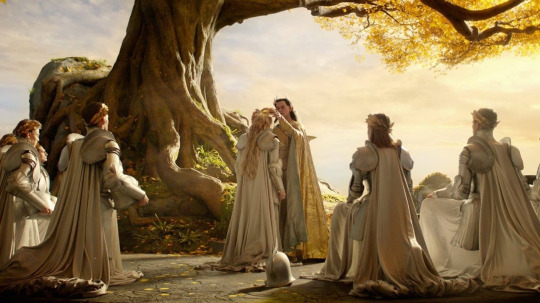
What's with the laurels? Did I miss something or...????:???^::??
And honestly I could go on and on and on on the elves ALONE, but a lot of people already covered that and this is already getting long enought so for my point here I'd only like to point out one detail that dialogues with my lazyness critique here, and it regards Galadriel.
Now, once again, I COULD GO ON AN ON ABOUT HER PORTRAYL (and I'll sure be doing a post addressing female archetypes so I won't extend myself here) but not my point here, I'd only like to talk about this particular dress:
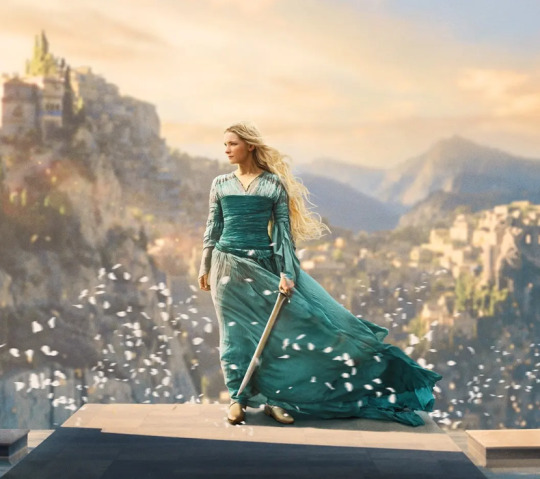
The blue dress
To be quite blunt, the thing with this dress is that it is literally a copy of Éowyn's maiden dress.
Literally.

It's so ridiculously blatant.
The impression it gives me is that they, once again, instead of even trying to show through writing or narrative construction a certain element, they simply copied and pasted the most obvious thing possible. They wanted to say "look at how Galadriel is a strong warrior woman" so they just made her look like the other "woman with a sword" in the franchise.
It was a big "she's the new Éowyn pls like her" move.
Instead of giving her... you know... her own construction? Some individuality? Any at all?
And that, in addition to being extremely lazy YET AGAIN, is a big shot in the foot (Brazilian saying, don't know if it makes sense in english sorry), because it only makes us compare the two directly. And even if you liked Rings of Power, I think we can all collectively agree that the Galadriel we were introduced to is definitely no Éowym.
So why did they do it??? because they're lazy that's it that's the point
It's the same with the thought of putting on a Wooden Elf with armor that looks like WOOD, or taking the concept of "people connected with nature" and translating that into purely shoving, idk, a bird's nest on people's heads and making them dirty with earth. Very connected with nature and stuff. It's just LAZYYYYY
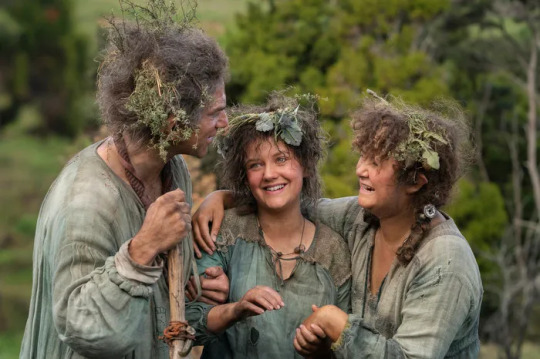
Yes, it's very cute, but.... Costuming-wise, it's just dumb?? You know?
And what screams the most is also the difference in quality between the costumes. The difference in the cut of the dresses, in the quality of the fabrics, in everything. IT SCREAMS. I won't get into that because, again, lot of people already covered that BUT REALLY, I'M SORRY, BUT THIS IS THE MOST EXPENSIVE MEDIA PRODUCTION OF IDK, EVER???? THIS FIRST SEASON ALONE COST NEAR THE BUDGET FOR THE WHOLE 3 LOTR MOVIES AND AND

THE PRINTED FABRICS I CAN'T EVEN-
Like, we had this:

And they thought we'd settle for THIS?????
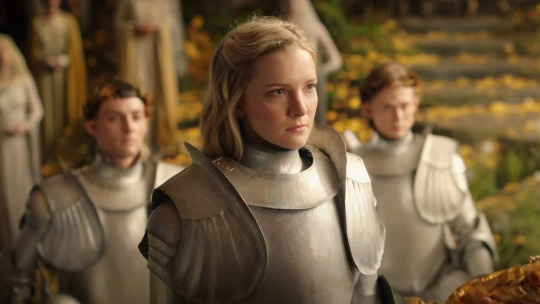
I could forgive this so easily if this was the standart fantasy production. I really could. But this is the most expensive production in history, produced by a billionaire mega corporation that exploits millions of people and literally kills our planet daily, about one of the most well-established universes in the fantastic imagination of our western culture. The least they could do was give us something with a minimum of effort.
I can't talk about their effort on other story elements because I haven't watched the entire series. But, I'm sorry, from the level of care and attention I've seen in these costumes… They literally just did the MINIMUM, and that honestly doesn't really get me excited for the rest of the production.
Like, because they said this character is Galadriel, should we immediately love her just because they said she's Galadriel? To me it fells like they took a LOT of things for granted, and unfortunately it shows.
AND JUST A SMALL ADDENDUM THAT I THINK I SHOULD MAKE
I know that in the big picture, the dwarf costumes are the least worst of this series, and I agree.
ALTHOUGH, YET, HOWEVER
I really think it's extremely complicated for you to represent dwarves as, again, "dirty" and "stubby" people who live in "rustic" caves and are "rustic" and "quarrelsome" and "drunkish". I… I just think it's bad.
Especially with the accent they effectively chose to use for pretty much ALL the dwarves, and seeing them interacting with posh Enrold with his perfect posh British accent… It's just bad.
And I loved Durin's personality and character, but in terms of costumes...
This:

Will never be this:
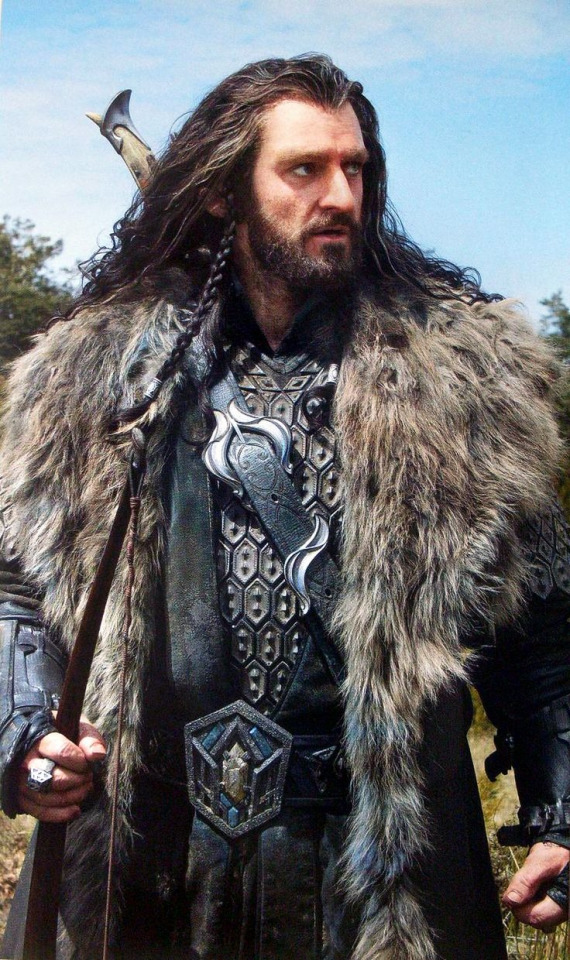
My personal feelings regarding The Hobbit movies aside, THIS is what a dwarf prince looks like for me. Simply as that. Just look at the condition of the fur in both costumes. C'mon.
Anyway, thank you once again for reading!!! This is just my opinion, as always, feel free to desagree with my at any point! ✨
#rings of power#lotr#and honestly I found it troubling and maybe disrespectful to make Sauron charismatic#like there's ac people rooting for him and he is ac rootfull#but that's just my opinion#galadriel#numenor#lord of the rings#the rings of power#costume analysis#costume design#movie essay
55 notes
·
View notes
Text
@ariel-seagull-wings @superkingofpriderock @metropolitan-mutant-of-ark
FUN FACT
In Northeast Brazil, there's a origin story for this whole torture the Saint Anthony thing: it says that once upon a time there was this lovely girl who couldn't find a husband, no matter what she did
She'd pray, and worship, and donate money, and lay flowers and candles and sweets, cakes and gifts for the saint and nothing would work, until one day she got so sick of it and so pissed that in a lash of anger she threw the saint image out the window BUT SO IT HAPPENED THAT there was a very handsome lad walking down the street that very moment, and the saint ended up hitting him on the head and knocking him out, so the girl hurried to aid him and long story short, THEY FELL IN LOVE AND MARRIED AND LIVED HAPPLY EVER AFTER
And that's (allegedly) it's the origin for the torture, because apparently it would be more effective
BUT also worth mentioning that Santo Antônio (Saint Anthony) is one of the most religiously syncretized figures in Brazil, having "counterparts" in African-based brazilian religions such as the Candomblé and Umbanda, and was also influenced by several indigenous religions; this may have contributed to the fact that in our "catholic" culture, to the worship of this saint (and honestly many others) was attributed a practice of slightly more polytheistic flavour: the bargaining.
It's very commom (specially on the countryside!) to find a full variety of catholic practices that actually revolve around the concept of bargain: gime that and I shall give you this in return, help me with that and I will offer you good favour / help me not and I will damn you and your worship
Such as: when you open a new bottle of cachaça (or any alcohol really) it's a "rednek" practice to puor the first glass on the ground as an offering for the saint of your most liking (my grandad's favourite was the Virgin Mary, he alone must have given the holy lady a few hangovers over the decades as a true feminist would)

108K notes
·
View notes
Text
How to Become a Real Boy: Our Flag Means Death and the Queer Art of Failure
Alright, batten down the hatches, I'm pulling out my mouldering English Literature diploma and writing meta about OFMD using some of my favourite queer theory. This is long for a tumblr post (about 1500 words) but also it's essentially a very condensed version of what could easily be a 3k word essay LOL. Can anyone tell I graduated a year ago and am missing getting to do this?
So, if you haven't seen it yet David Jenkins' pinned tweet says "A lot of what we’re taught about being a man is wrong." And other people have written eloquently about this but clearly the show is exploring masculinity. But the thing I think it does differently than other media I've seen that interrogates masculinity is that rather than just criticizing it (and I think the show is doing something much more interesting than critique) it actually portrays a diverse array of alternatives.
Humour in OFMD doesn't operate under the still-too-common model of ironic cynicism. I could do a whole post just about that on its own but to try and be as concise as possible rn I'm going to quote David Foster Wallace (who I know was a shitty person but his point here still stands):
"Irony’s useful for debunking illusions, but most of the illusion-debunking in the U.S. has now been done and redone. All we seem to want to do is keep ridiculing the same stuff. Postmodern irony and cynicism’s become an end in itself, a measure of hip sophistication and literary savvy. Few artists dare to try to talk about ways of working toward redeeming what’s wrong, because they’ll look sentimental and naive"
We know about toxic masculinity, we know it sucks, we know the patriarchy hurts everyone. Now what? The thing that OFMD does differently here is also showing us alternative kinds of masculinity that aren't toxic-- Lucius admiring Fang's body and telling Izzy that "we don't own each other," Doug hyping up Mary's artwork and bringing her breakfast in bed, Stede getting the pirates to "talk it through as a crew," the crew getting to sew flags and do silly theatre, Ed being told he "wears fine things well."
And here's where we get to my main argument: I think one of the main ways that OFMD arrives at these alternatives is through what Jack Halberstam calls "the queer art of failure."
Super quick rundown of this concept:
The terms of success in a heteropatriarchial, capitalist, colonial society are toxic, and failing to achieve these things can open you up to otherwise hard to see ways of living differently. "Under certain circumstances failing, losing, forgetting, unmaking, undoing, unbecoming, not knowing may in fact offer more creative, more cooperative, more surprising ways of being in the world." To put it simply, once you've totally failed to be straight enough and masculine enough and white enough and whatever else, you become free to explore the alternatives to these things.
So, ok, what does this mean for OFMD? Well, as I said in a previous post I think its main thematic question, which it sets up in episode one with the Pinnochio story, is "how do you become a real boy?" (a real pirate, a real gentleman, etc.). And the season's answer to that question is, ultimately, "you can't-- because there's no such thing."
If we think of each of these fixed identities (gentleman and pirate) as being at the top of some very tall mountain, then Stede and Ed each appear at first glance to be relatively close to their respective peaks. Stede has a wife and kids, a beautiful house and more money than he knows what to do with. Ed: well, he's Blackbeard, history's greatest pirate. But what's so fantastic about this show is that one of its major premises is that even Blackbeard isn't actually the perfect ideal he's made out to be. And if even Blackbeard can’t make it, can’t be the pinnacle of masculinity, then maybe that’s because nobody can.
Notice that the second time the Pinnochio story comes up in episode one is right after Stede says "my family is here now." The next cut has him reading aloud to that new family, the crew of the revenge, in a scene that shows off a kind of new fatherhood, a masculinity based in caring for others. I'd argue that the reason the episode ends on this scene (and the shot of all the flags displayed equally) is to tell us that while the crew may say that they're keeping Stede alive because he proved himself in battle, ultimately they're really doing it because they like being told stories and getting to do crafts together. This queer chosen family, then, comes to all of them as a result of Stede's failure to be a real gentleman (by leaving his hetero family) and his failure to be a real pirate.
And that's why Ed likes him so much, and is so interested in him in the first place! He's the only guy out there doing something new and exciting. Of course the joke is that the only reason he's doing something original is because he's totally incapable of being a "real pirate" but that's the whole point. Stede questions why he can’t be both a gentleman and a pirate but ultimately the show is about him coming to terms with the fact that he has failed to be either of those things-- and that's good, because they allow him to eschew the toxic terms of success of both.
Some more quick examples of this:
Stede failing to be a traditional father and husband opens up new possibilities for Mary, who herself is freed of her societal expectations by “failing” to be a wife anymore
Jim’s story is also about failure, failing to hide as a man, failing to live up to their revenge legacy quest. But again through those failures they find the alternative: being non-binary, falling in love with Oluwande, etc. if Jim’s lesson is that revenge won’t make them feel better, won’t bring back their family, then they can only find freedom in failing to do so (which is where they are at the end of the season).
And ok now here's the really interesting part: while Stede and Ed both fail, in different ways, to be real pirates and real gentlemen, they both also have a running thread of being unable to fail. Ed can't fail because he doesn't even have to do anything scary anymore, people are so terrified of the idea of him that just showing his face sends everyone running. Stede can't fail because his privilege-- and main character magical plot armour-- insulates him from suffering real consequences (as Badminton says, "here you are, unscathed, God's perfect little rich boy"). Each of them is trapped by their proximities to the ideals they represent (pirate and gentleman, respectively), and that is why each of them goes back to those identities in the end.
Stede fails to be a pirate, goes back to being a gentleman and then fails to be a gentleman too. And only when his failure is complete, and he reckons with the consequences of that failure, is he able to sail off toward something else. And importantly I don't think that something else is being a "real pirate." He's sailing toward love, vulnerability, queer family-- all of the things he found by failing to reach the terms of success offered to him by both identities. Ultimately Stede doesn't become anything, in a fixed sense. Instead he, though failure, opens himself up to an ocean of possibility.
Ed, on the other hand, ends the season before he can complete his failure arc. He fails to be a gentleman, goes back to being a pirate, and then...? Well, then, I think what this means is that Ed's next step in season 2 is to truly fail to be a pirate. Like Stede, he needs to complete his failure and reckon with its consequences. We can see this foreshadowed by him crying in his final shot-- the gaps and friction points in his identity have opened up and are ripe for failure. Ed thinks, right now, that he has to stay being Blackbeard, being the Kraken, because the stakes for failure are too high. But Stede, (perhaps history's worst pirate) is coming back to him full of failure and freedom. And I think only once Ed really truly fails-- and survives it-- will he be able to meet him there.
The world we live in is a cynical place, and it is in the best interests of the people in power to convince us all (like Ed has been convinced) that the stakes for failing to follow the rules, failing to go along with the success terms of heteropatriarchal capitalist colonial society, are too high. And it's true that failure sucks and it hurts, but it is also true that there are people out there who are living otherwise, people who will help you get through. And I think that's what this show is about: not being so naively optimistic to think that you can fail without getting hurt, without reckoning with consequences, and at the same time not being so cynical as to believe you have no choice but to scramble forever toward an impossible ideal. Instead, you can fail and survive it, fail and keep failing, and in doing so open yourself up to an endless horizon of ways to live differently.
#oh wait what if I apply skin shows to the kraken metaphor#this is just too beautiful#love how you applied halberstam's theory here#it fits perfectly ur a genius#ofmd#our flag means death#queer theory#ofmd meta#ac now i'm looking back to halberstam other works and going#now I want to reread all his work with ofmd in mind#thank you so much for that
1K notes
·
View notes
Text
the way ofmd deals with masculinity is so fascinating. we have stede, who’s about the least masculine a character could possibly be in the traditional sense: he gets sad instead of angry, he refuses to engage in physical violence, he encourages talking about feelings, he likes fashion and interior design and romanticizes everything. he likes picking flowers. and he has been told for his whole life that he is worthless because of all of this. he has been bullied and taunted and abused for it, but that didn’t keep him from adding a secret closet to his ship (lmao) to keep his excess fineries. he is still outwardly himself.
then we have ed. ed who is the pinnacle of the idea of masculinity, part of why he was remembered as history’s greatest pirate in the first place. he’s violent, ruthless, quick to anger, hierarchical, and his name, blackbeard, even emphasizes a symbol of masculinity. he’s revered for his masculinity. his performance is so powerful that people surrender before he even shows up in person. but it’s not him. blackbeard is a character ed has played for as long as he could remember that served to protect him from harm. you can't get hurt if you're never vulnerable in the first place.
when he meets stede, he finds someone he doesn’t have to present as blackbeard for. he can indulge in the frilly colorful clothes, the dancing, the emotional honesty that stede treats as normal. ed lets stede hold his heart in his hands and stede calls it beautiful. and stede, for the first time, has met someone who doesn’t see those things as hateful or embarrassing. everything stede has been mocked for unequivocally delights ed. in the reverse, stede sees blackbeard as the man stede never was. the ideal of a pirate that he read about and romanticized before he became one himself. to stede, blackbeard is everything he could never bring himself to be.
when ed begins to outwardly become interested in stede’s way of life, izzy serves to try to force him back into that hypermasculine presentation of Blackbeard. izzy hates stede for all the same reasons stede has been hated his whole life, and he sees stede as poisoning edward with his embarrassing foppish behavior, emasculating him. this comes to a head when ed signs the act of grace, shaves his beard (the symbol of his performance of masculinity), and kisses stede. all of those go against traditional masculine norms and by extent, the idea of Blackbeard. but ed isn’t performing anymore. he smiles more after the kiss than he ever does in the rest of the show.
then, stede is held at gunpoint by chauncey, who calls stede a monster, a plague for ruining the greatest pirate in history. ruining through emasculation, which in countless other media has been presented as horrific. think about other media that puts masculine characters in prison or the army (the similarities are staggering)—the threat of beating the character down until they’re submissive and emasculated is ever-present. losing the appearance of masculinity is by and large seen as one of the worst things that could possibly happen, and is often paired thematically with the loss of autonomy.
so stede agrees. he’s horrified with himself. he himself was already not traditionally masculine, and he spread it to blackbeard like a disease. everything he (and, interestingly, the viewer) has ever been told is that ed’s shift throughout the show is something to be terrified of. ed shaving his beard, in stede’s mind, confirmed his worst fear: stede had made ed into everything stede hated about himself and wanted to change; he killed blackbeard. but what he and chauncey and izzy can’t see is that stede actually gave ed more autonomy, more freedom and comfort to be himself and do what makes ed happy.
so stede runs. he runs back to where he once performed masculinity as a father and husband (regaining his own beard, so to speak), now sure that blackbeard would have been better off not knowing him. on some level, stede does want parts of blackbeard’s edge to stay (he’s like izzy in that way) and is scared he’s somehow excised it permanently. ed doesn’t want to leave it all behind either, but he’s terrified that stede could never accept the side of him that still exists as blackbeard. i also think this is why ed didn't try to kiss stede until he was the least like blackbeard he could be; he saw it as being less likely to get rejected for the ugliness he saw in himself.
it's interesting that ed doesn't go back to being blackbeard immediately after stede abandons him. at first, he goes all-in on the emotional vulnerability, trying to hang on to the hope he had allowed himself to experience when stede had agreed to run away with him. hanging on by a thread. the thread snaps when izzy mocks him for pining after stede, for lacking the masculinity izzy required in order to maintain his respect. in quick succession ed was rejected by stede, whom he loved, and izzy, whose respect he'd had since before the show began. so he threw his walls back up. he painted his mask back on, closed himself off, and removed every reminder of when he had allowed himself to be vulnerable.
ed's return to masculinity is not presented as a good thing. it's a trauma response, a defense mechanism, and it's toxic. the show experiments with defining a line between toxic and non-toxic masculinity; izzy, calico jack, the kraken, stede's father, the admiral twins, they all represent the ways toxic masculinity enforces a culture of violence and punishes any emotion except anger. stede and his crew represent a healthier version of masculinity: emotional honesty, encouragement and care for others, kindness, and love. it's not an accident that as ed allows himself to love and be loved, he begins to leave behind the toxic aspects of masculinity he had before. i've used the word emasculated to refer to ed's transformation throughout the show, but in truth that's not entirely accurate. it lines up with how many people would view what happened to him, but in reality he did remain a man, he just became a healthier one.
#hadn't picked the beard simbolism to this extent I am now speechless and teared appart#thank you so much for this#our flag means death#stede bonnet#blackbeard#thank you taika
11K notes
·
View notes